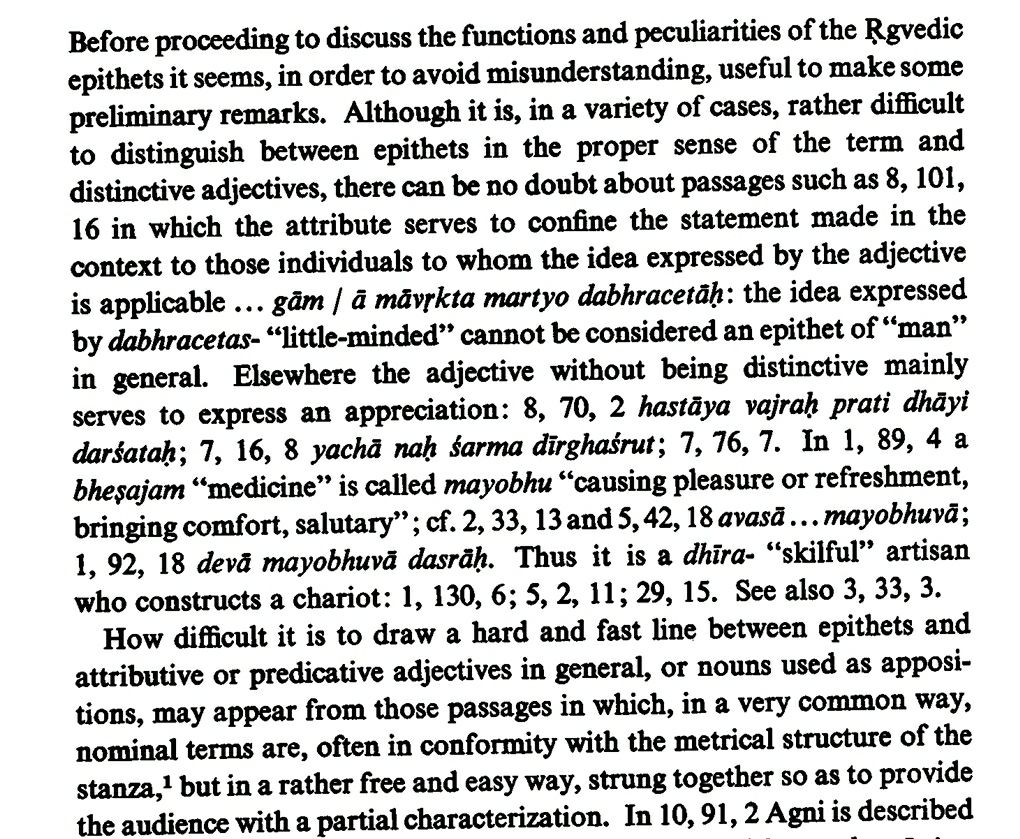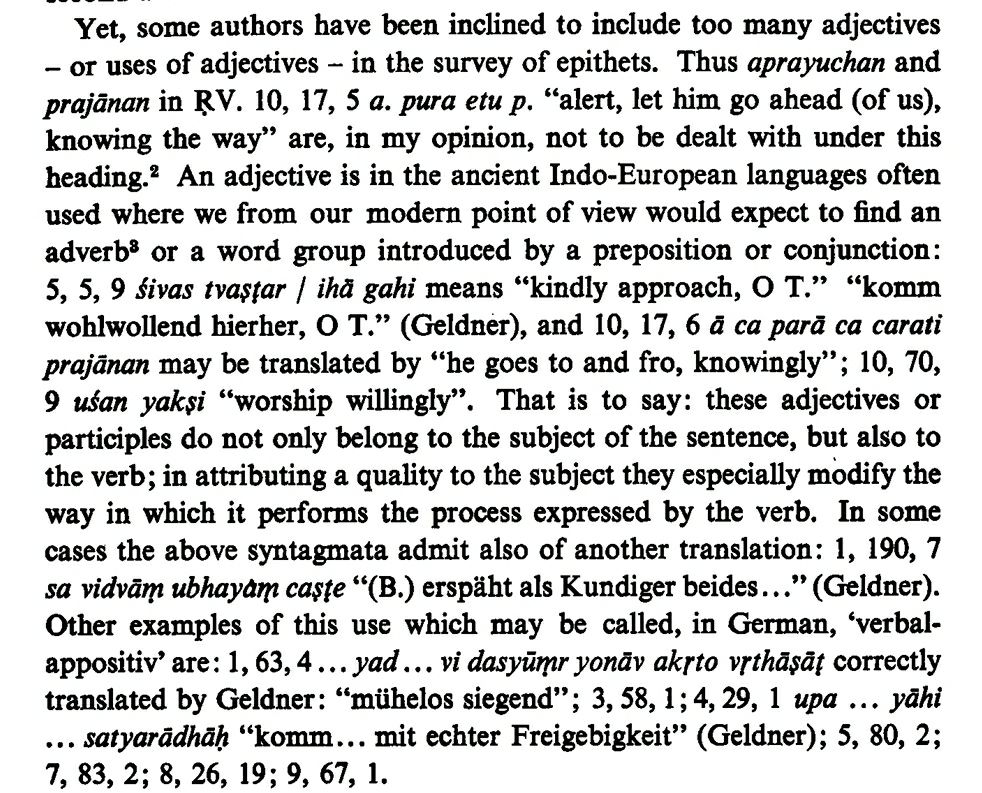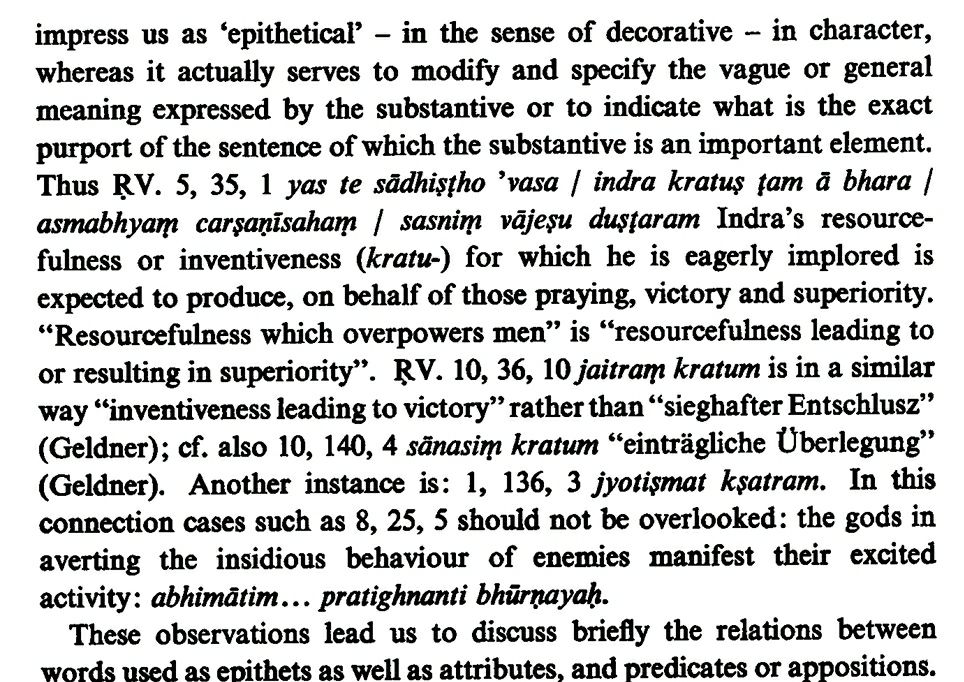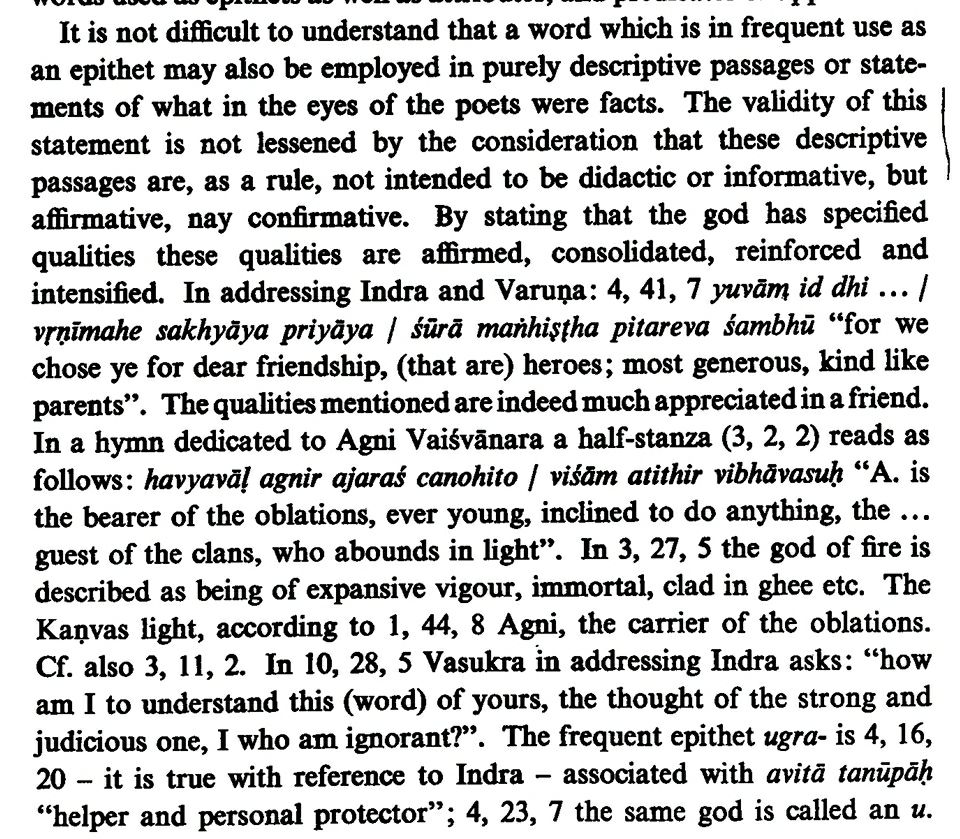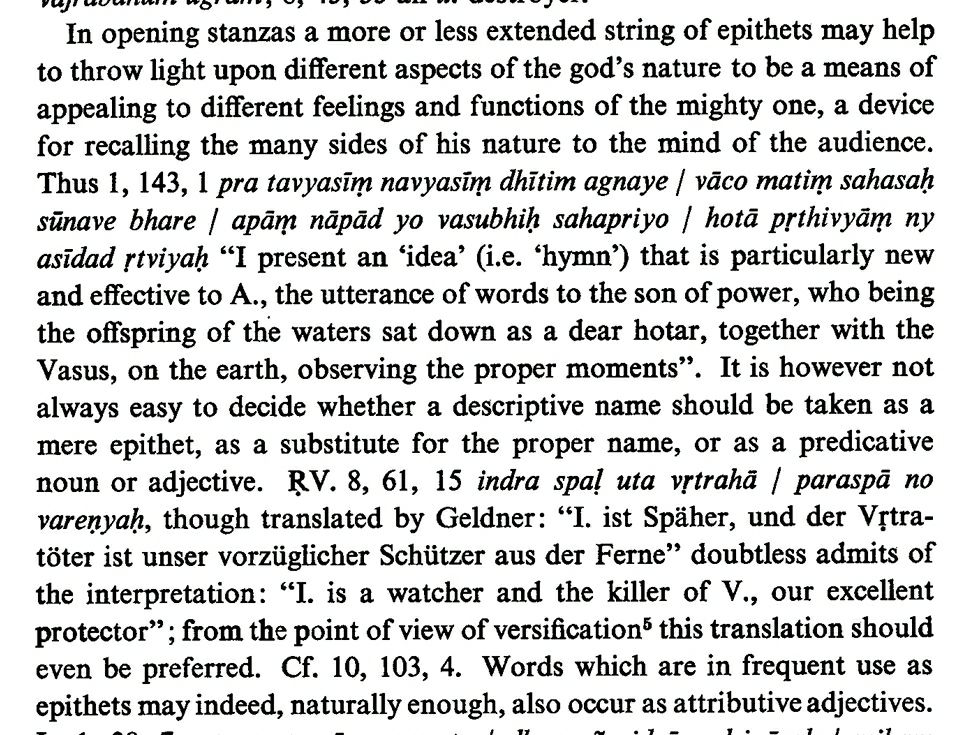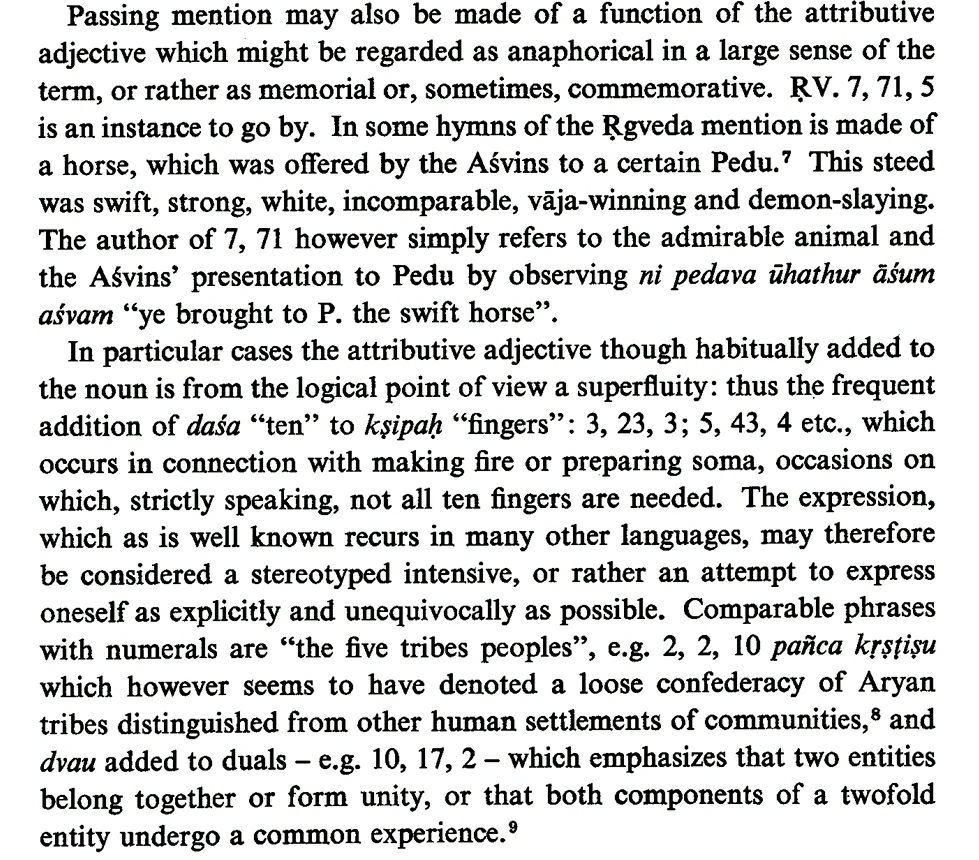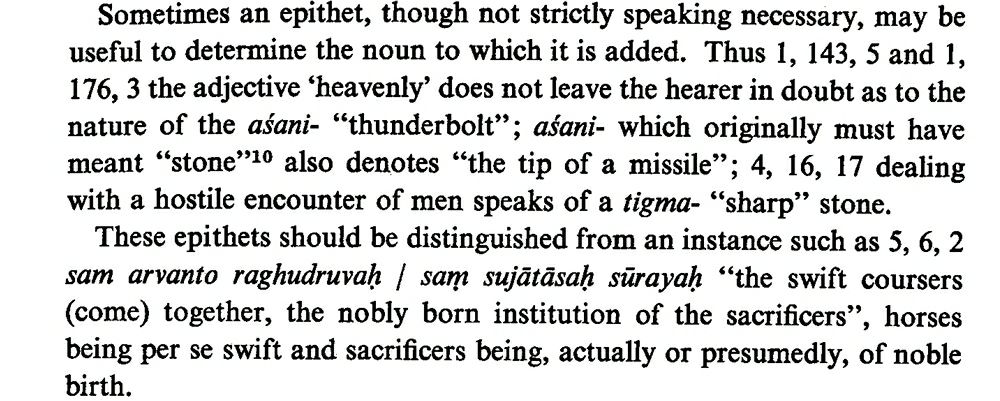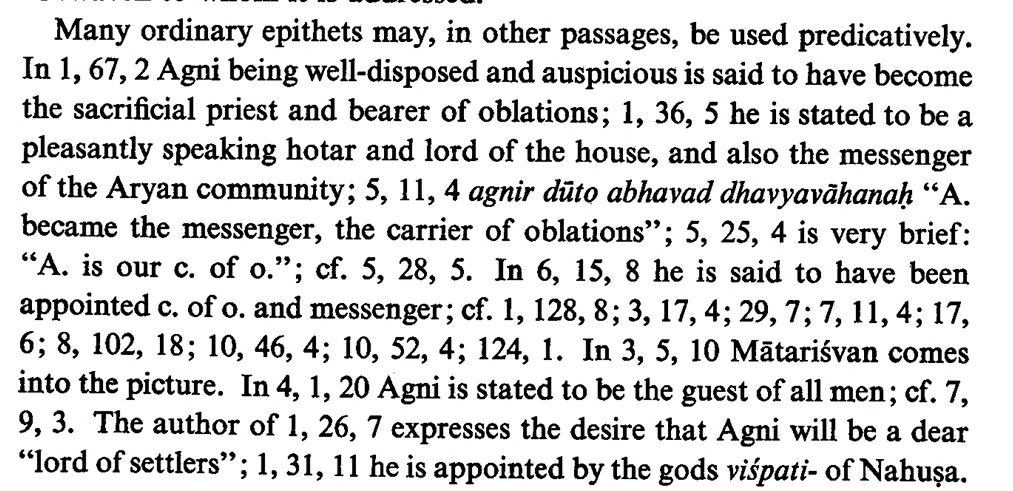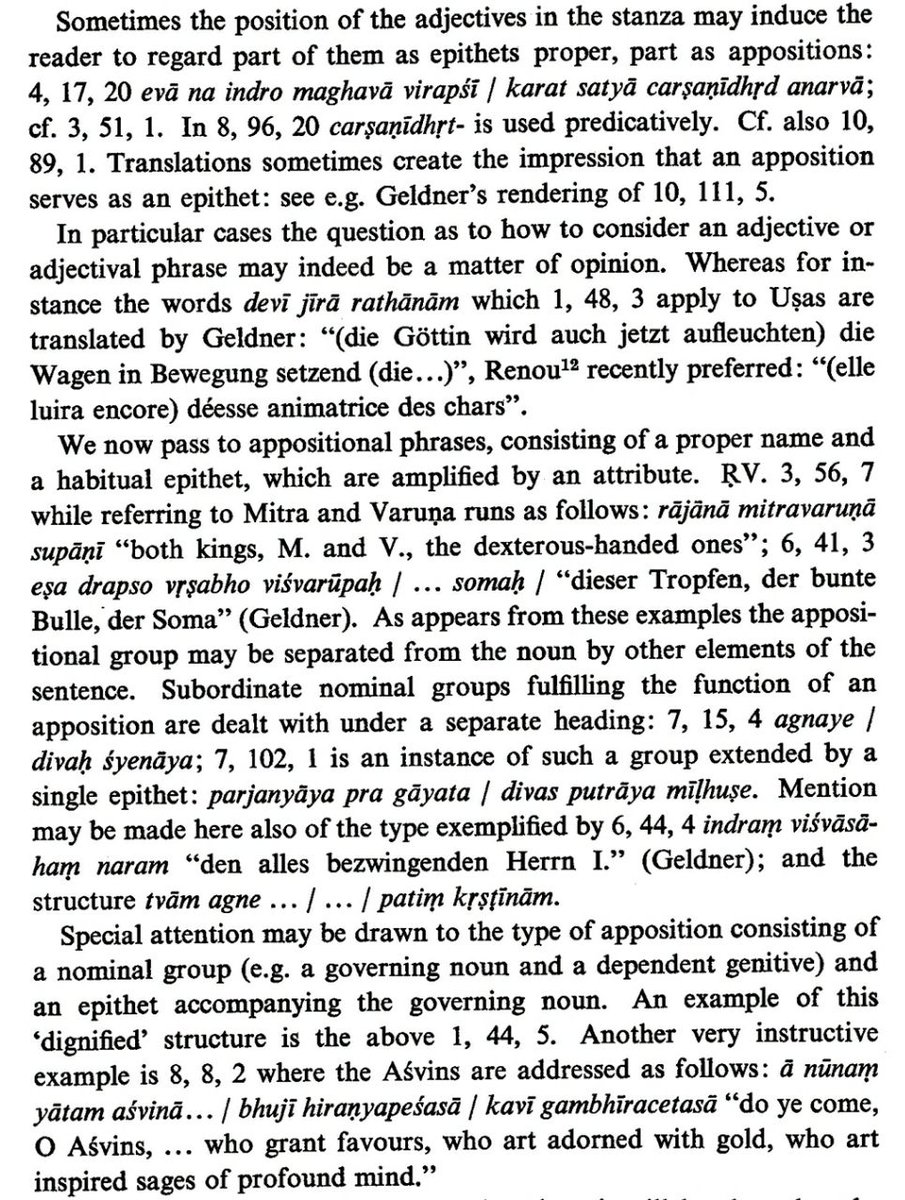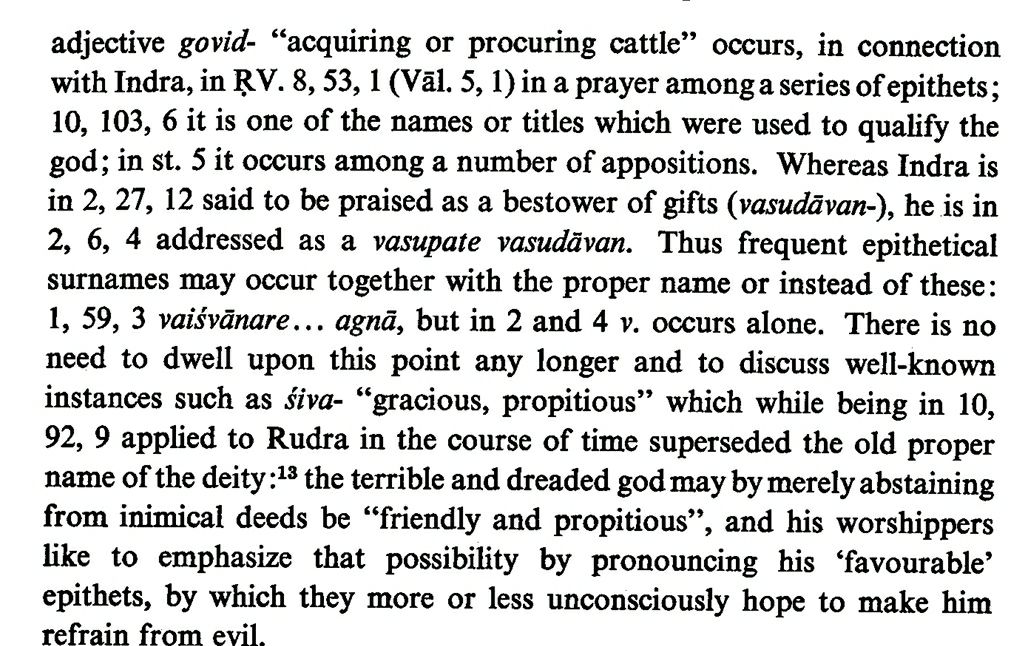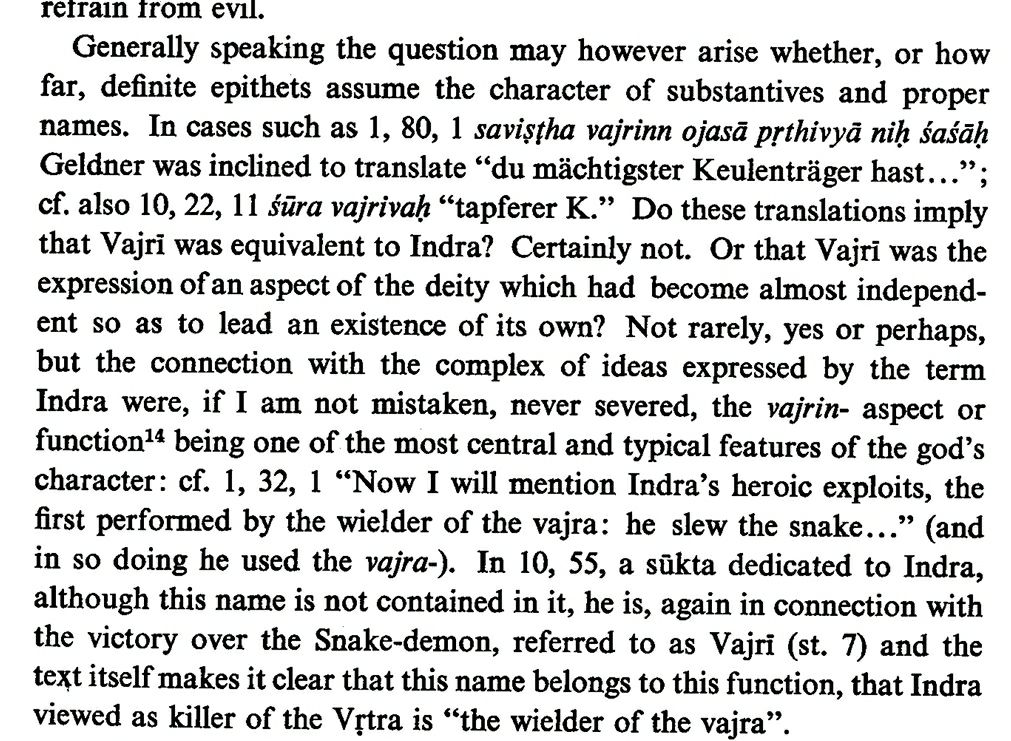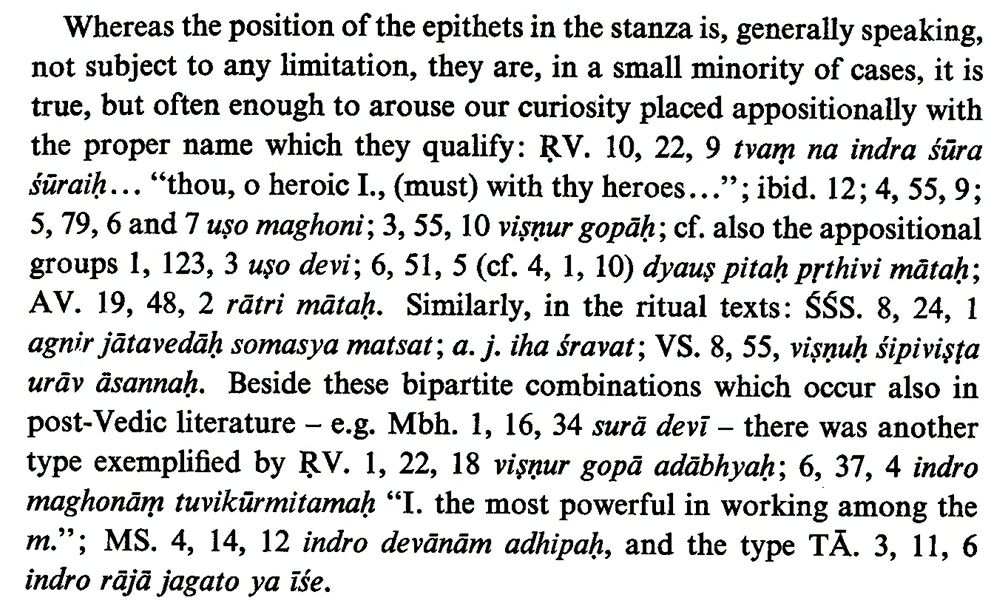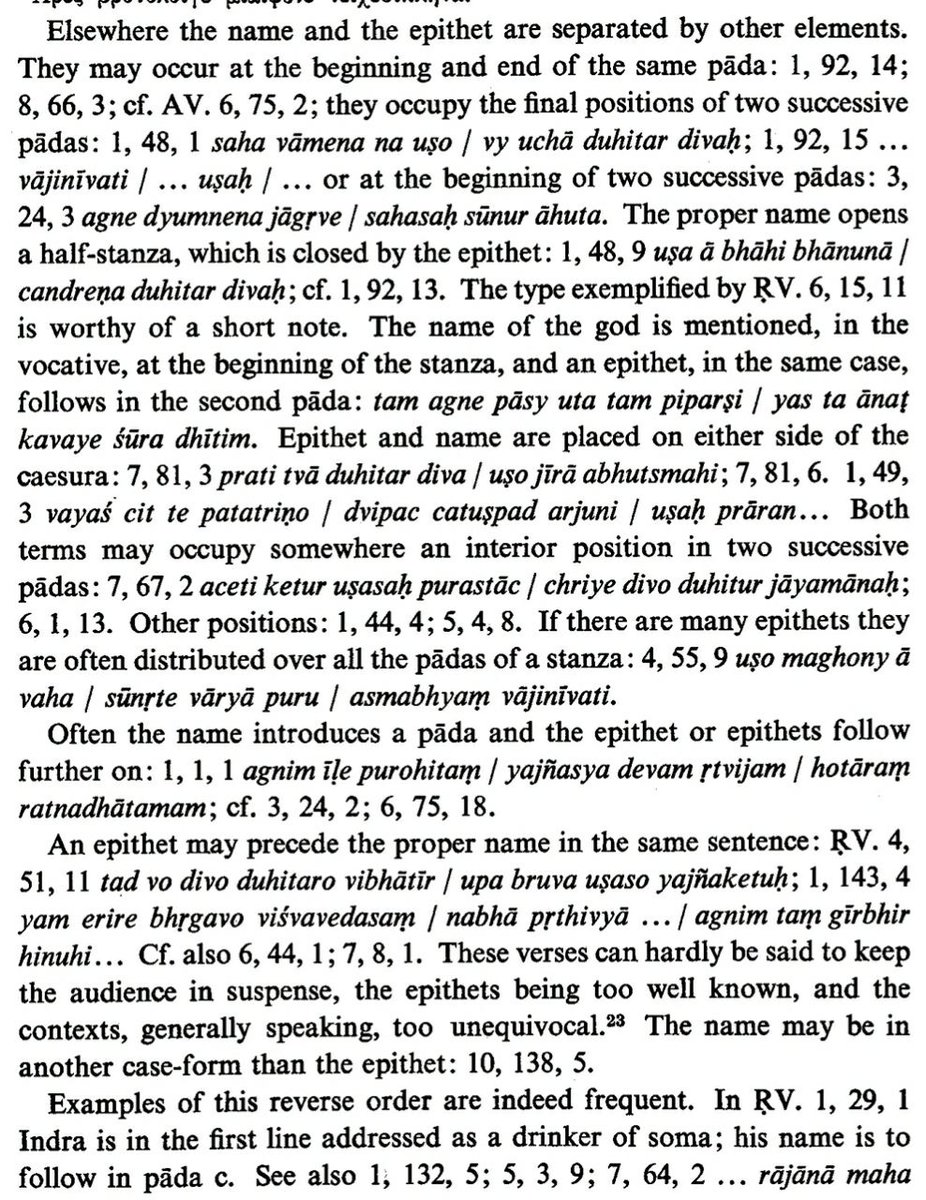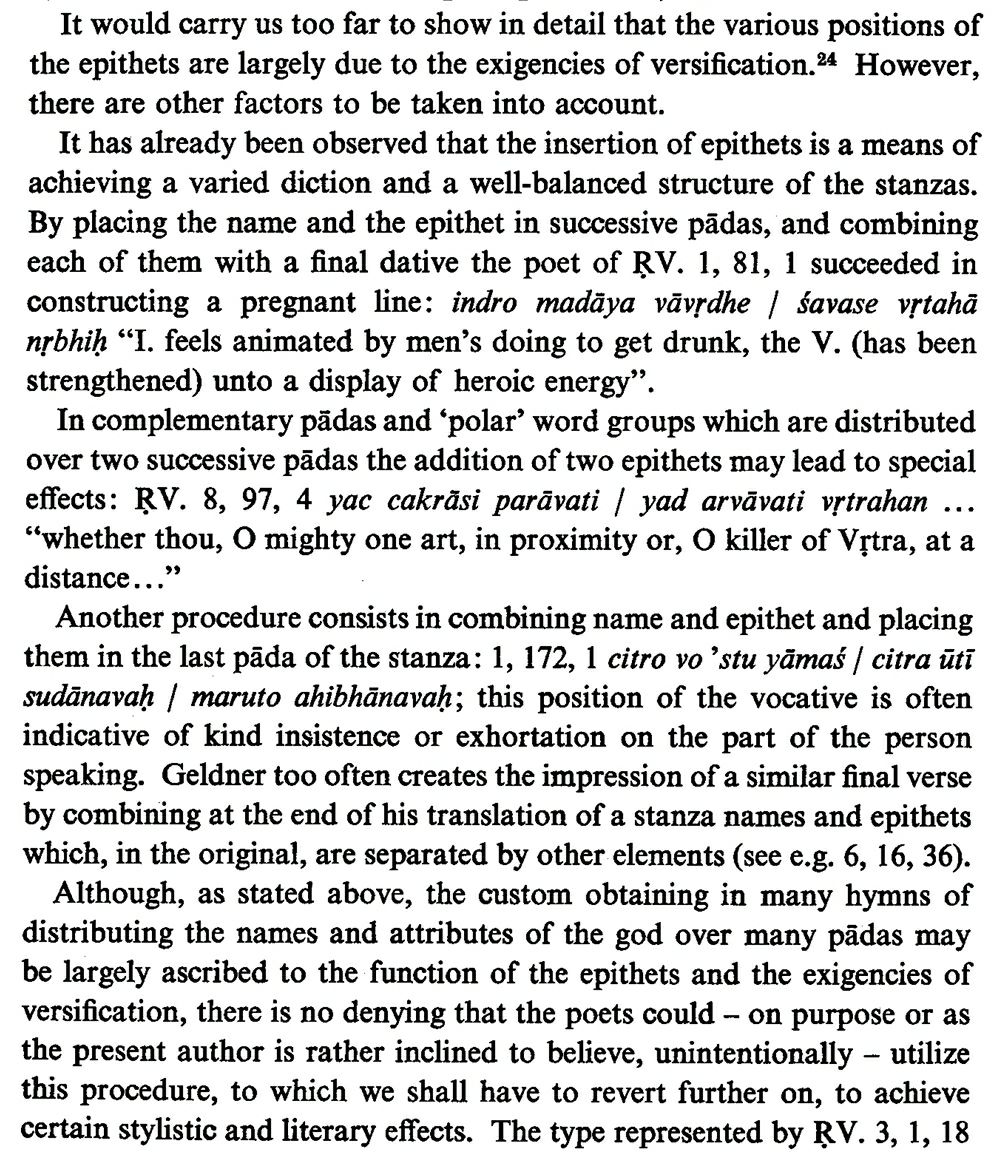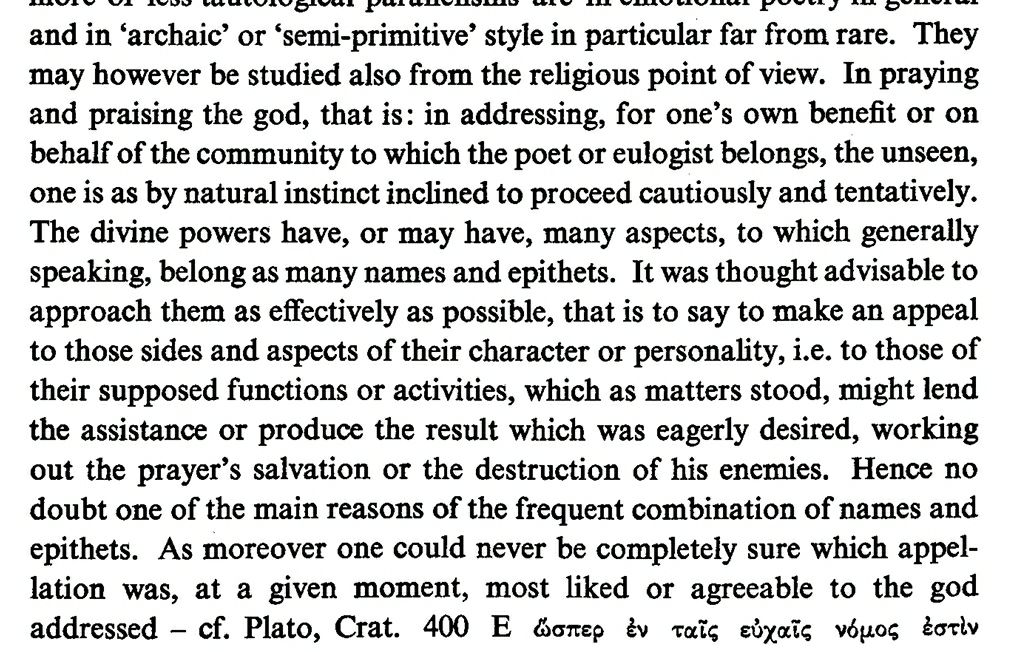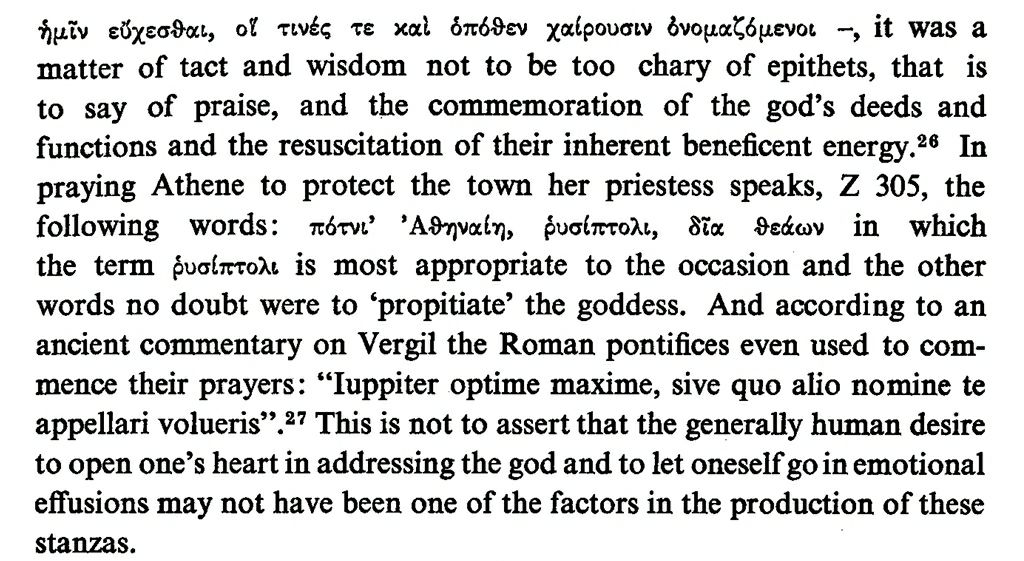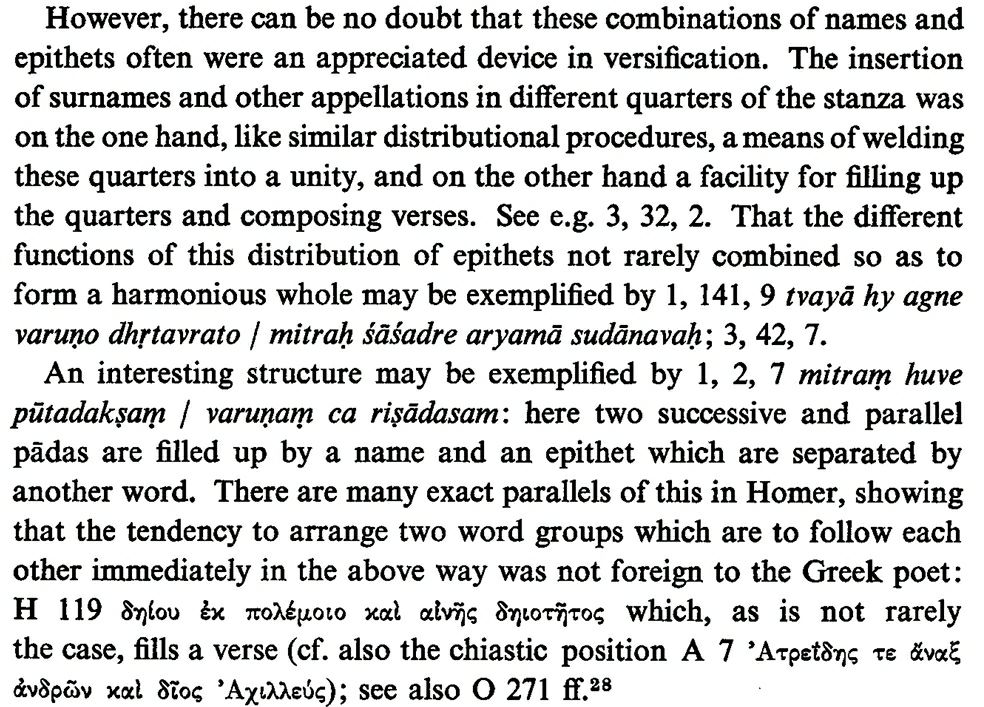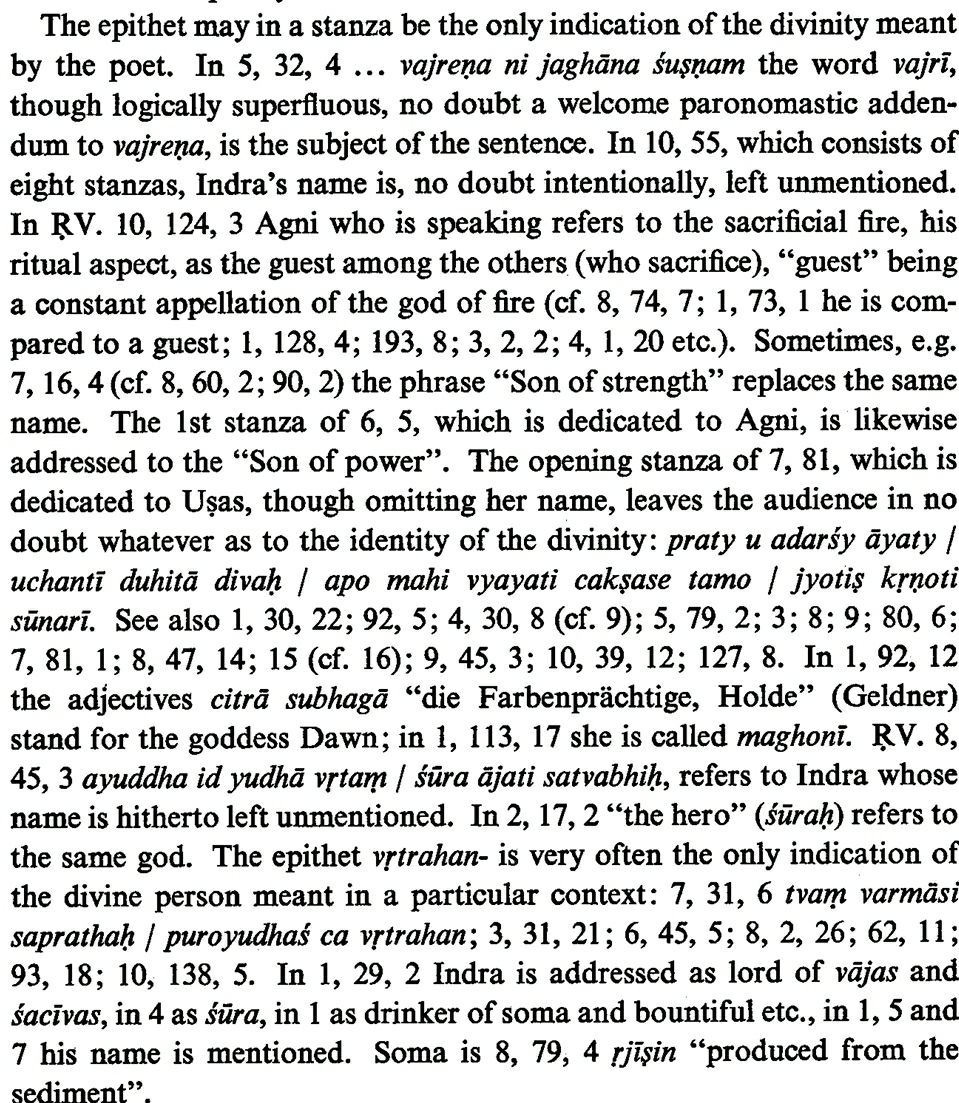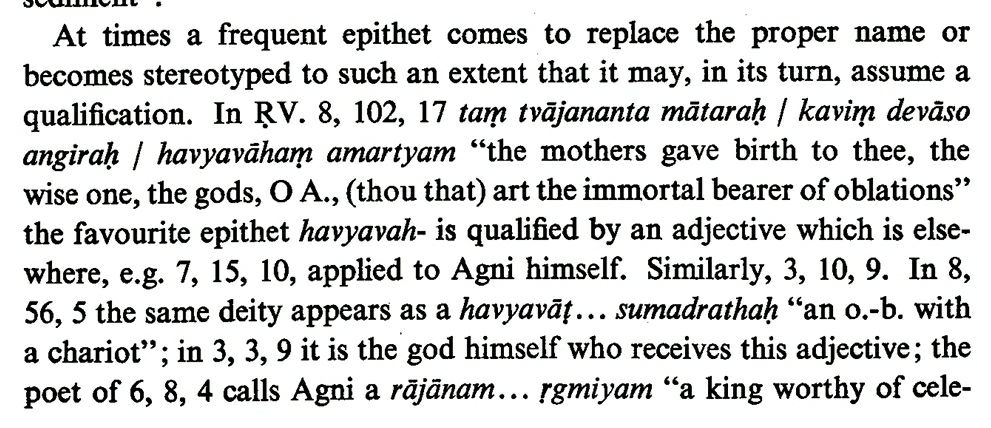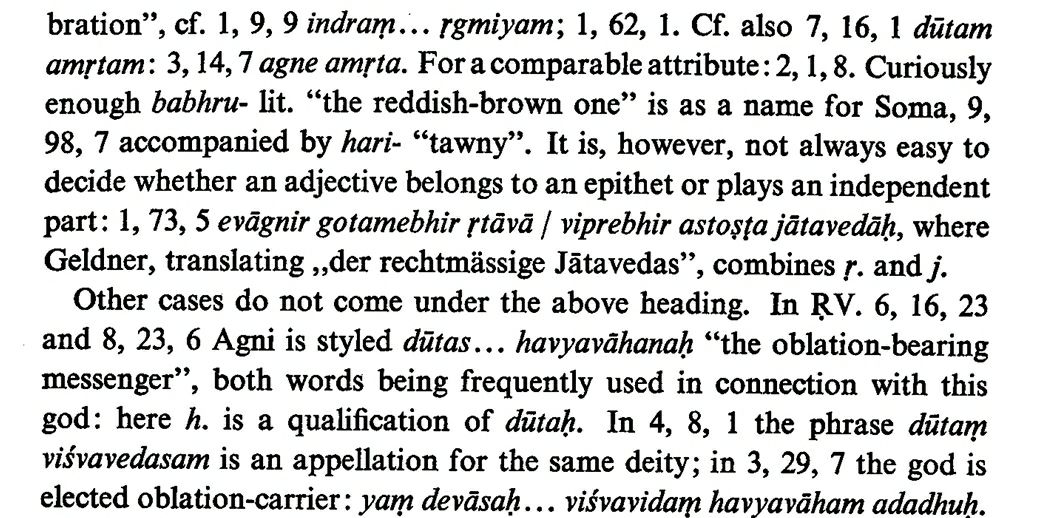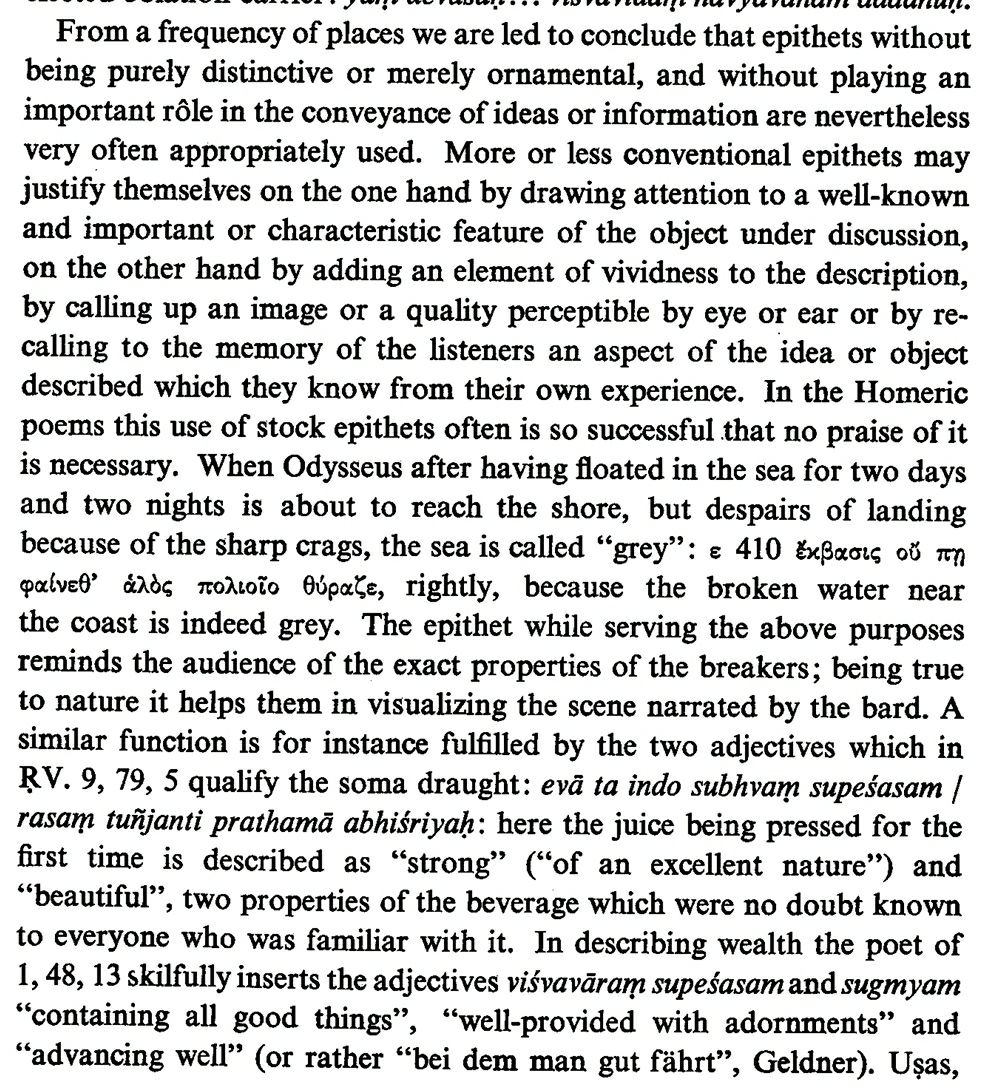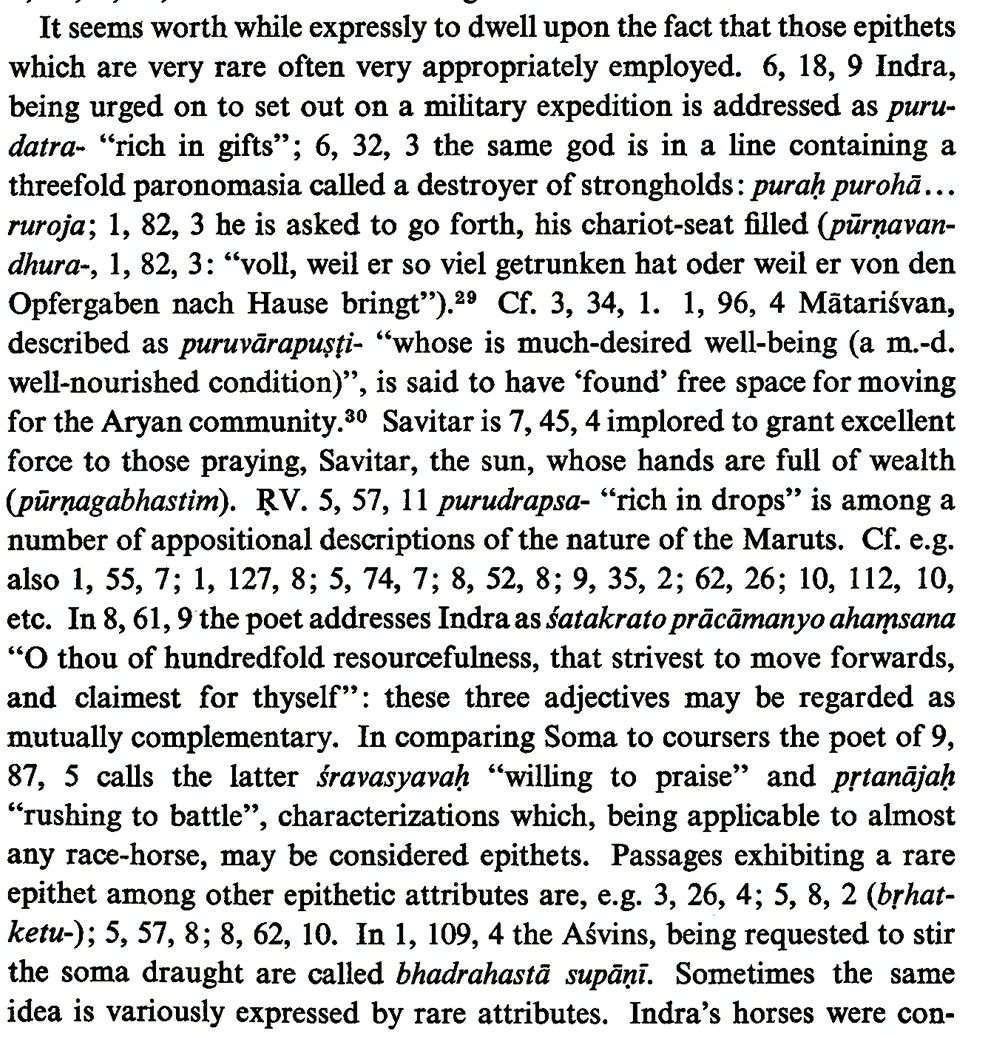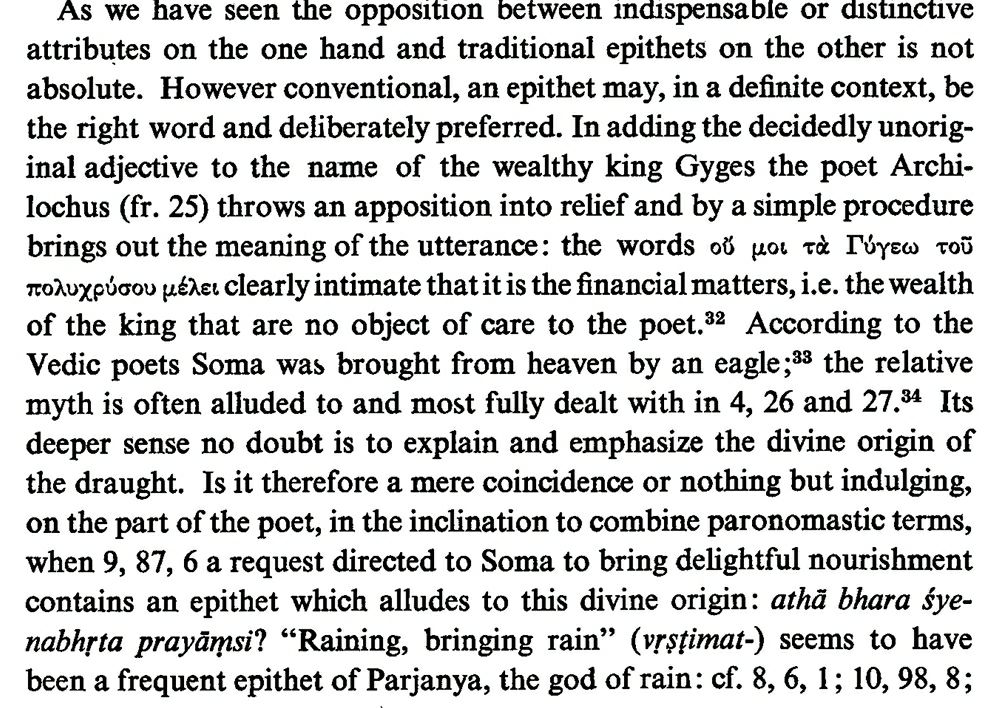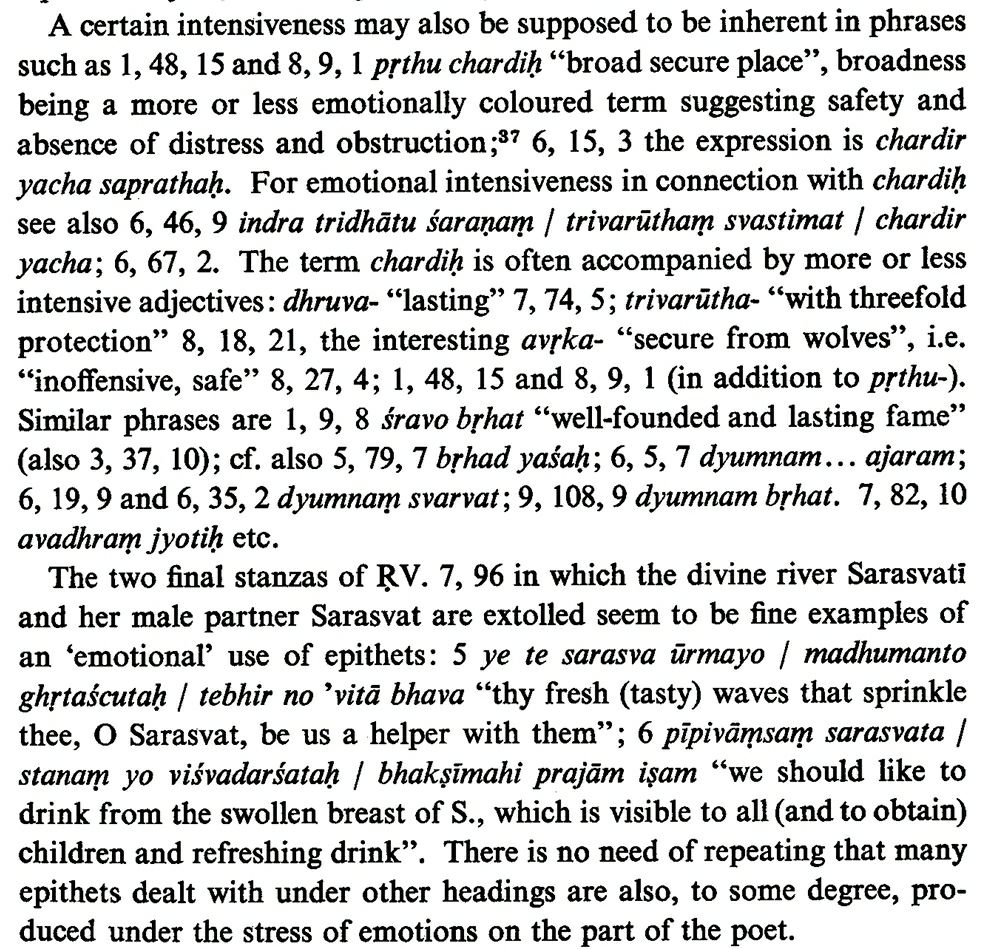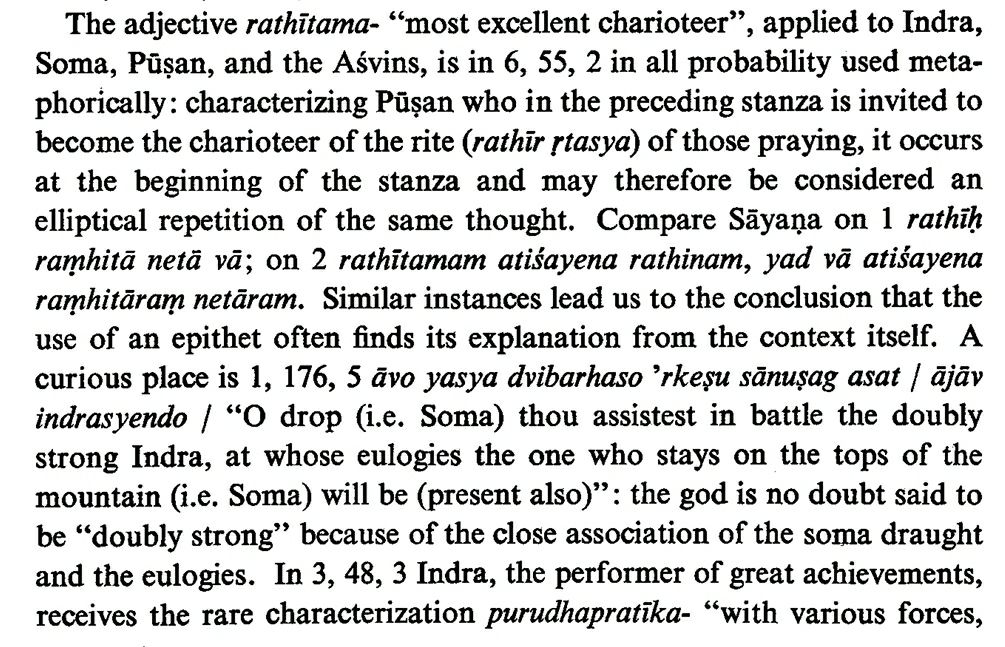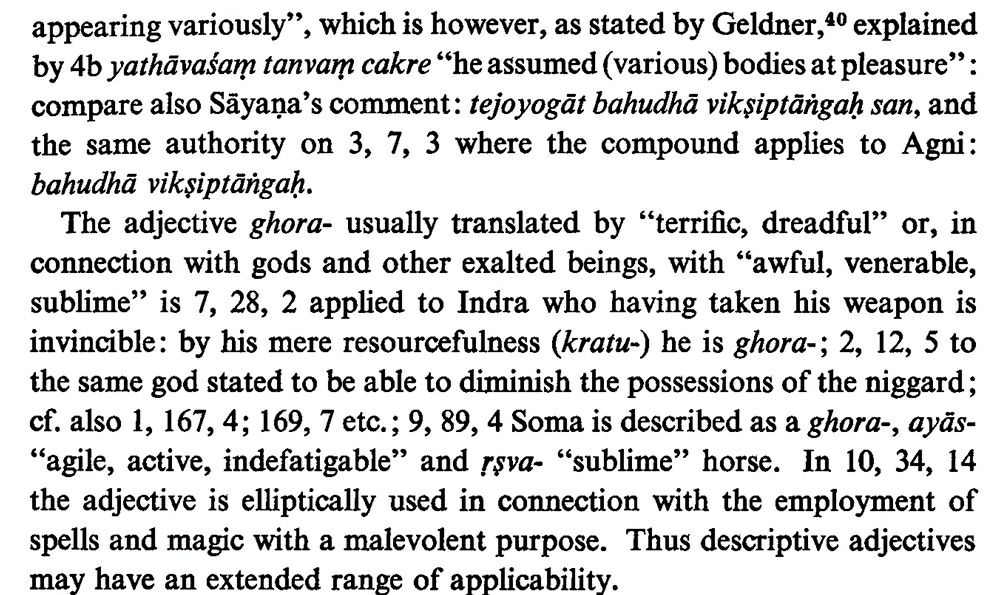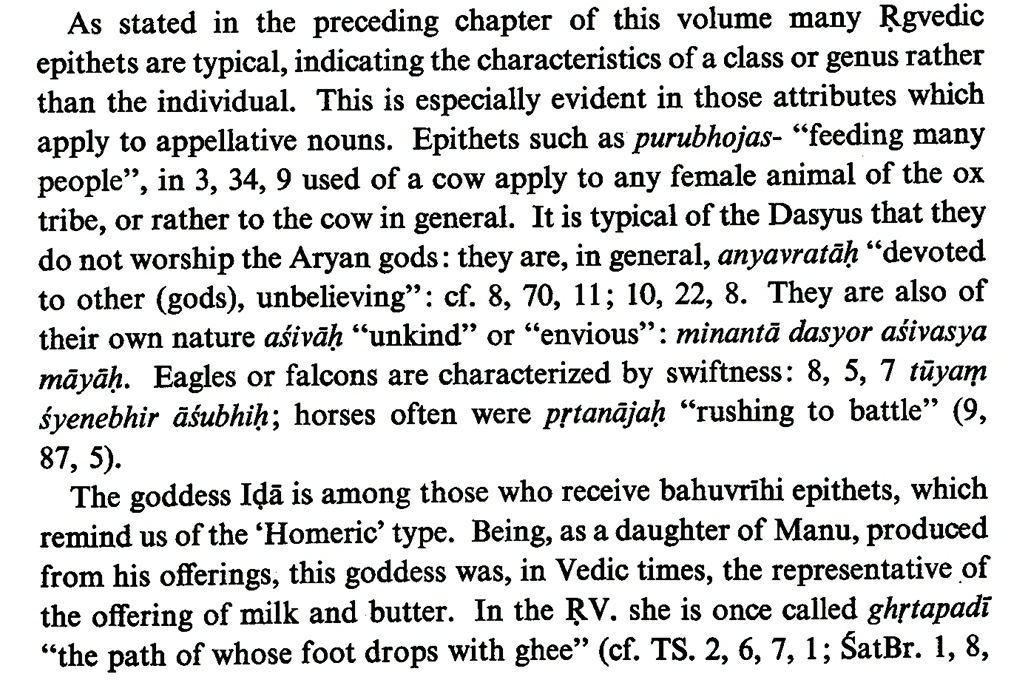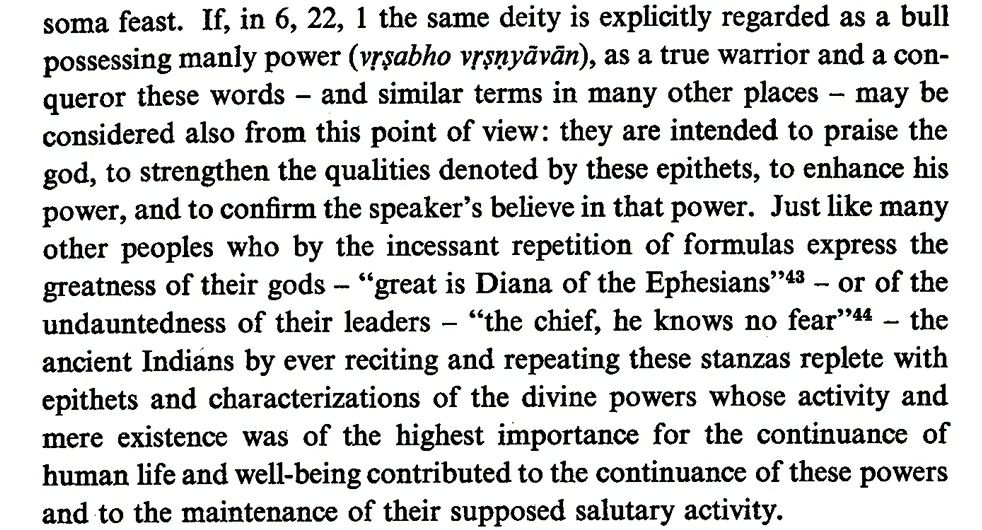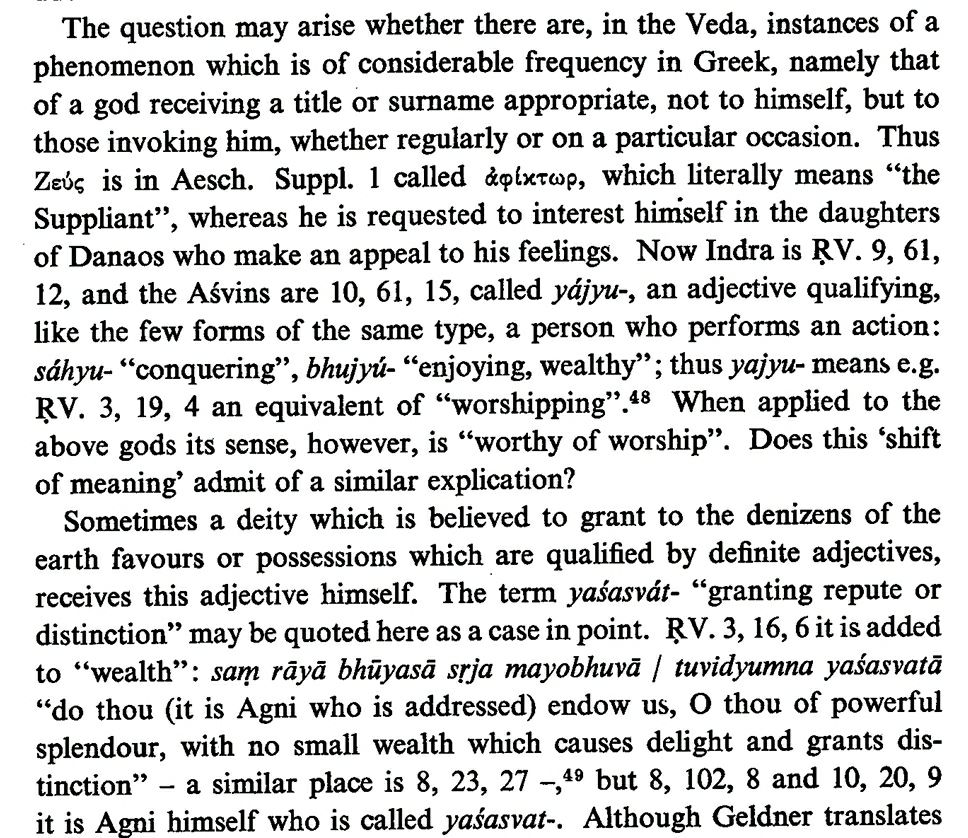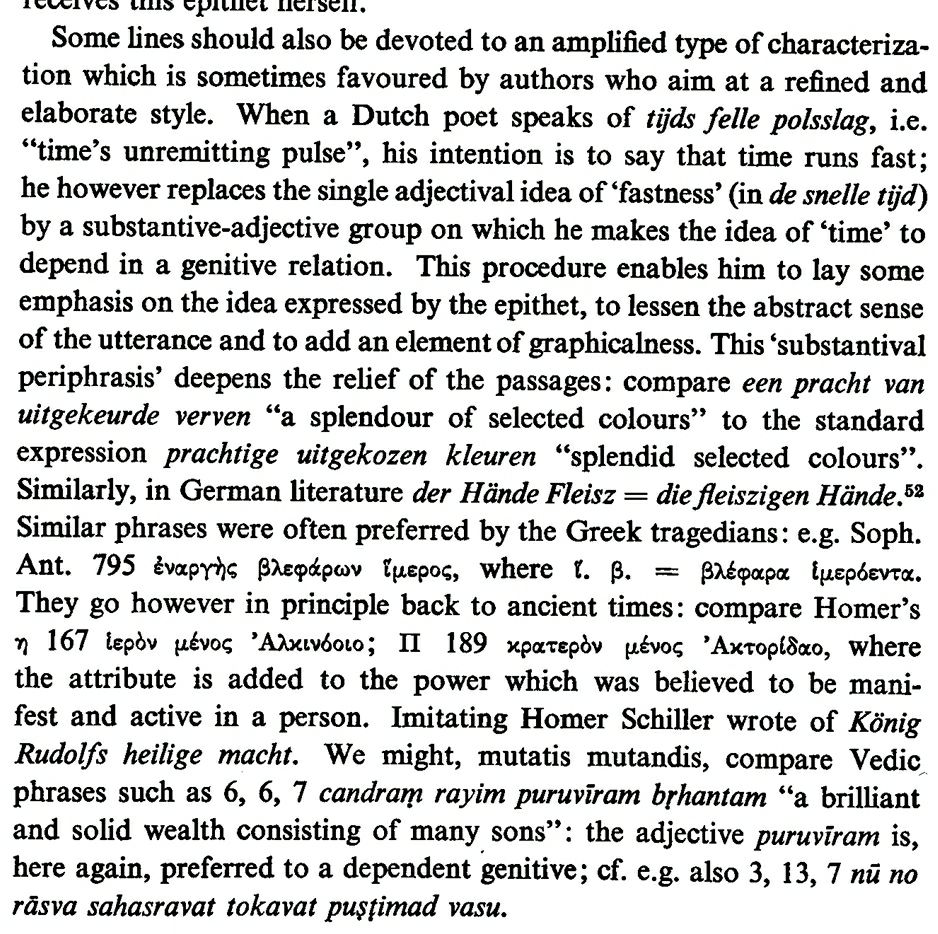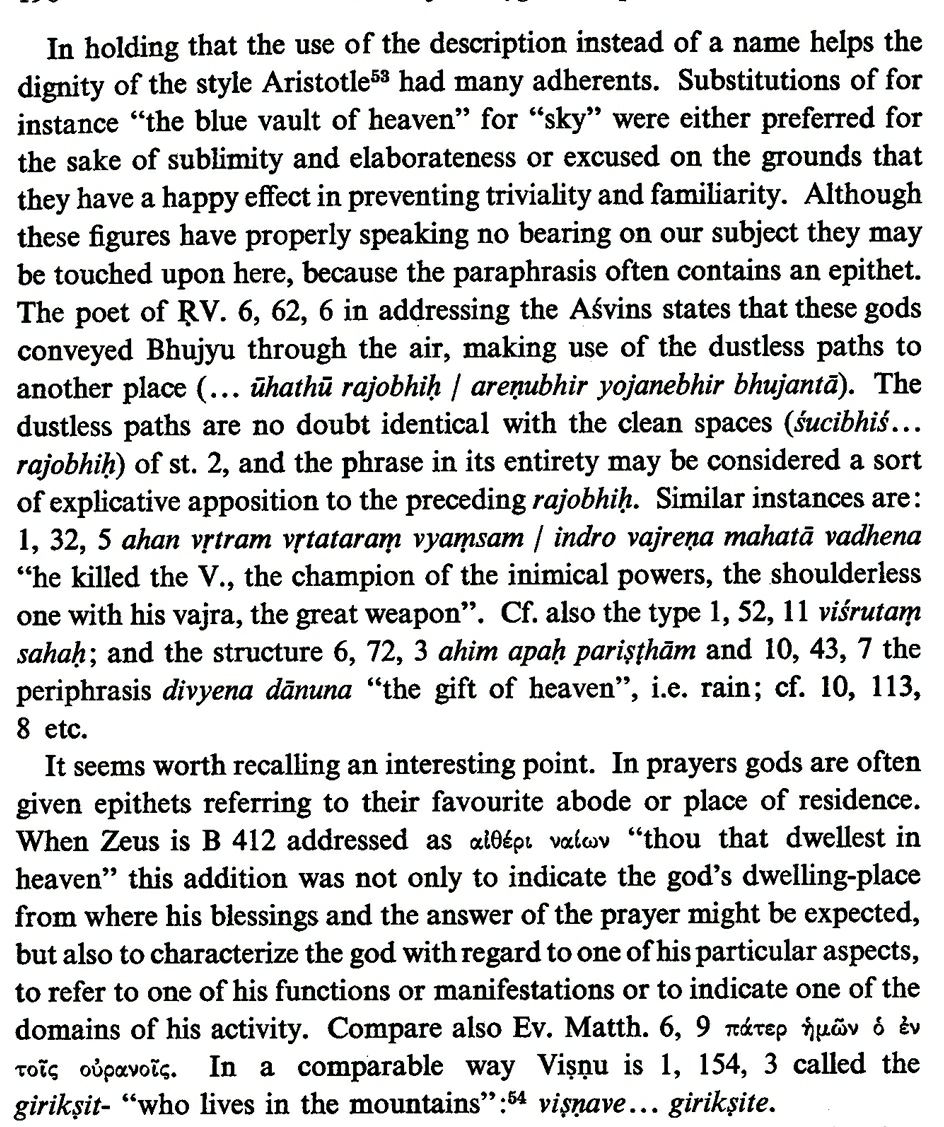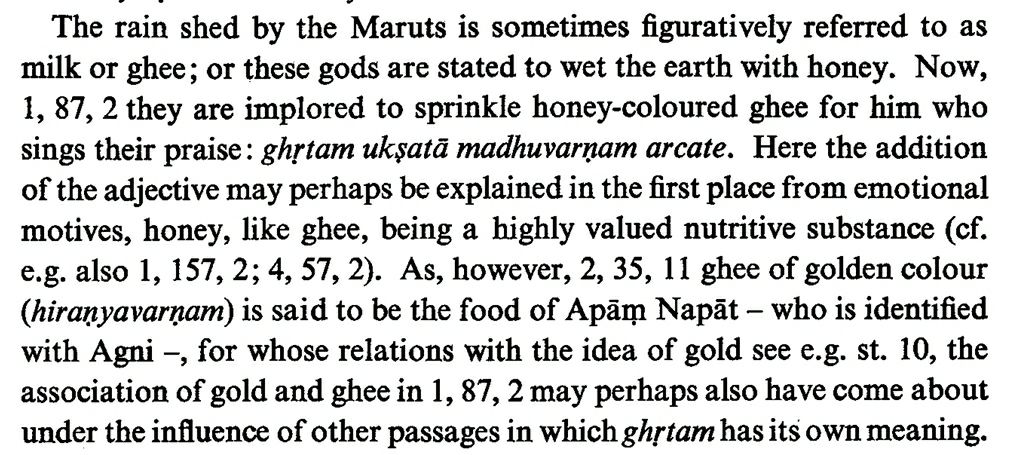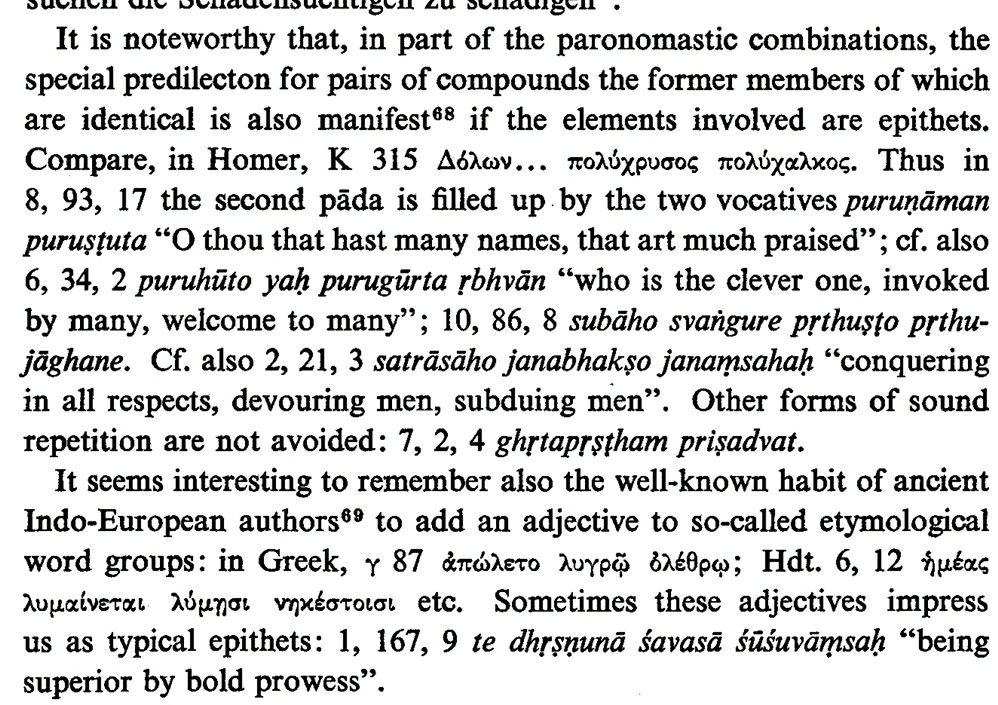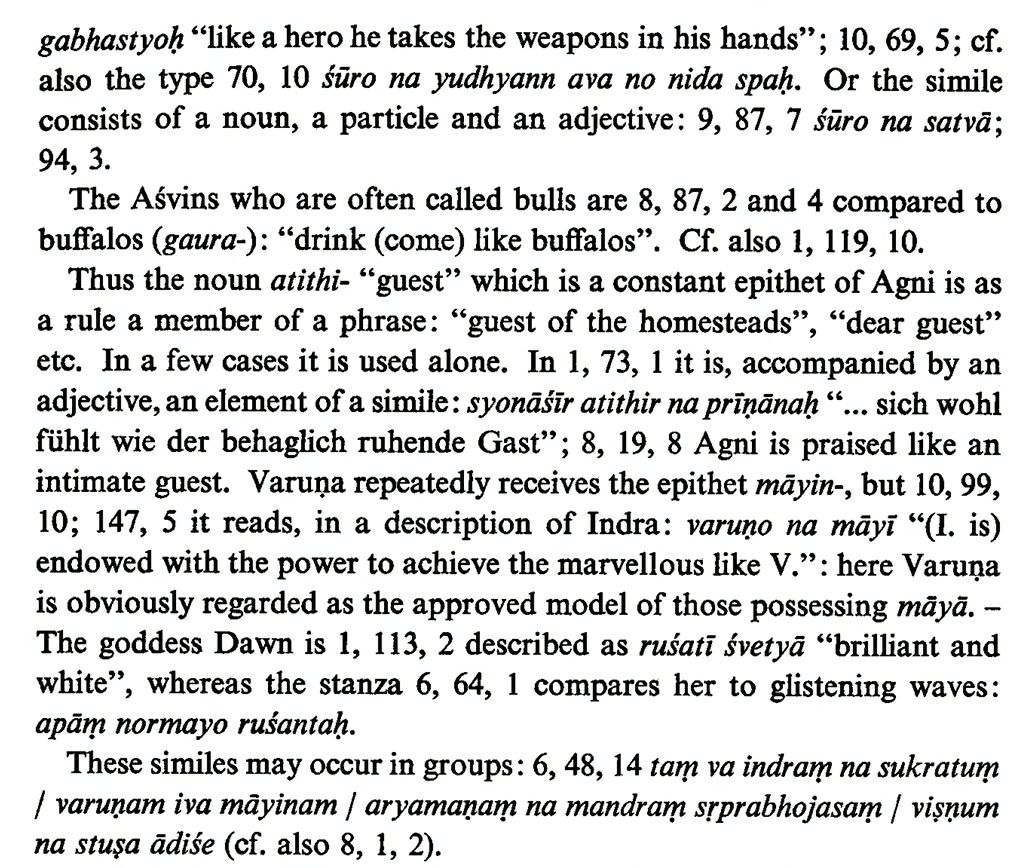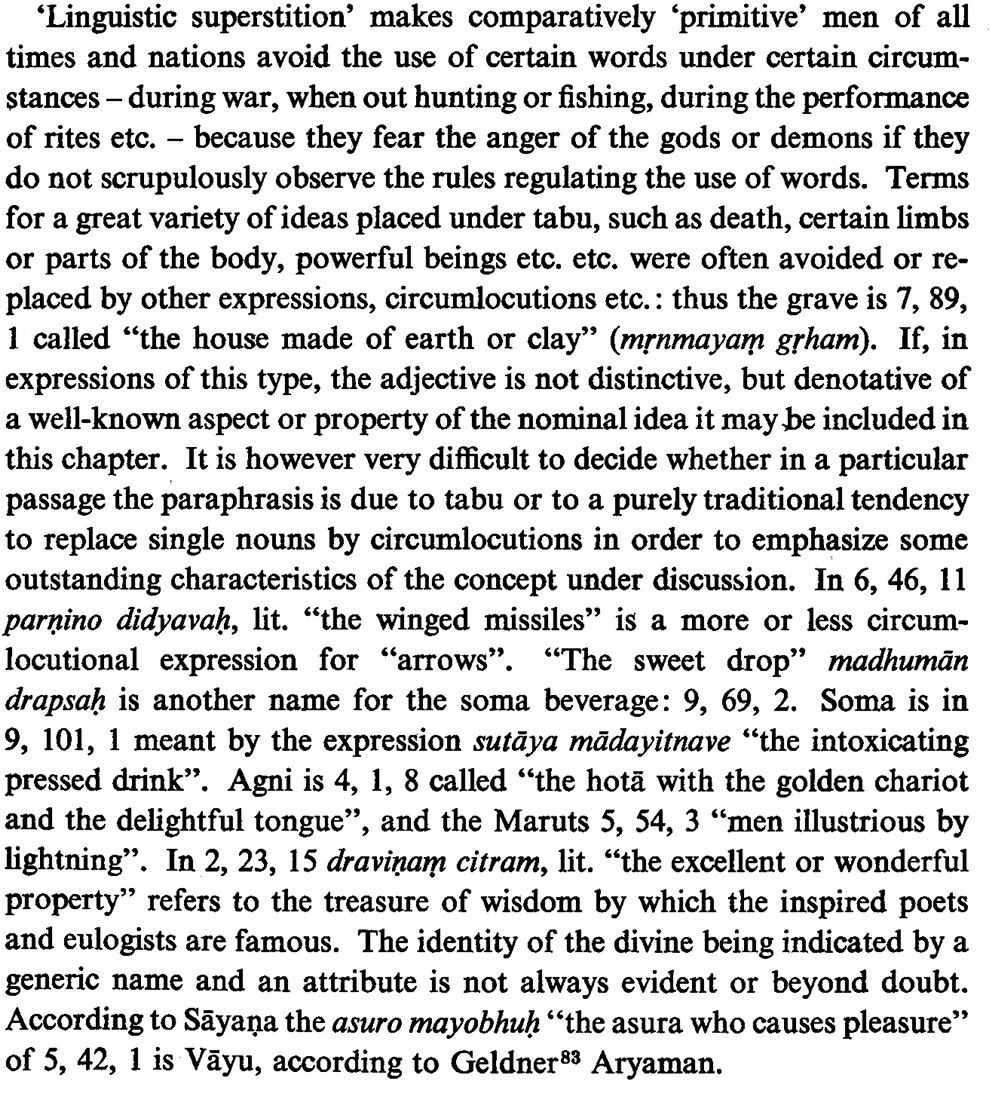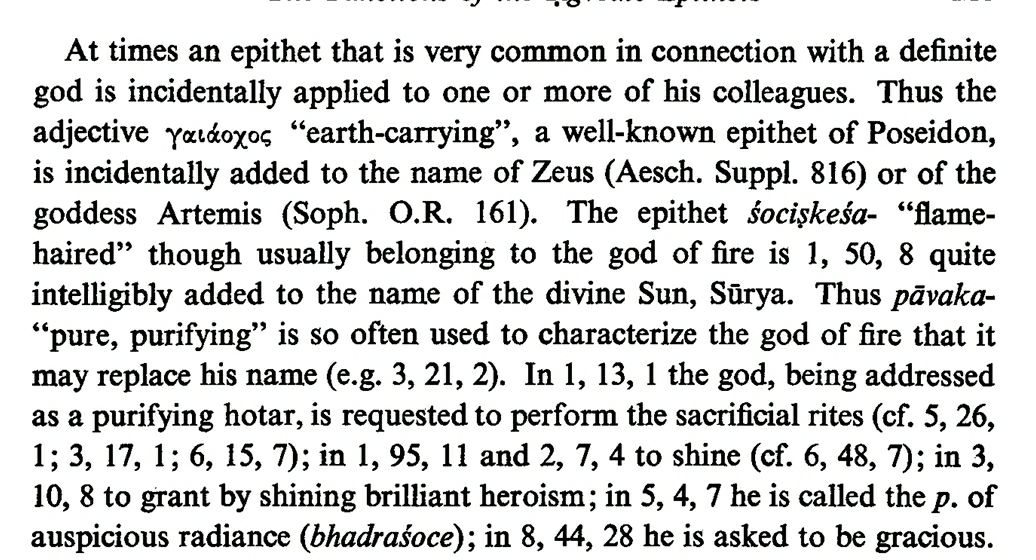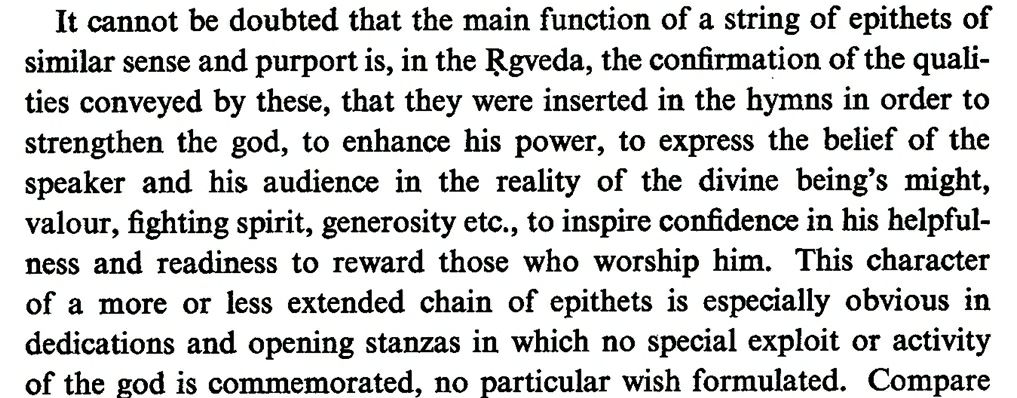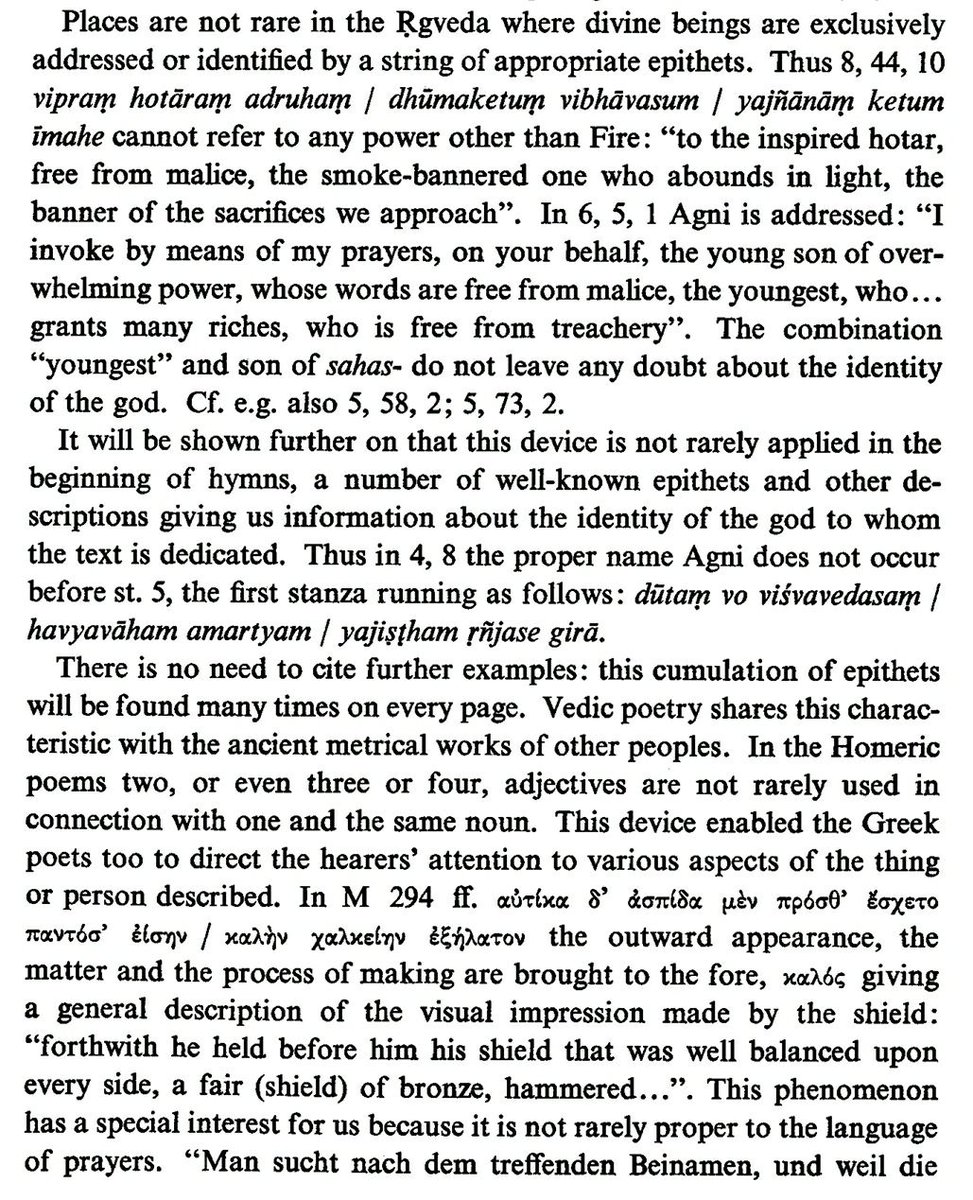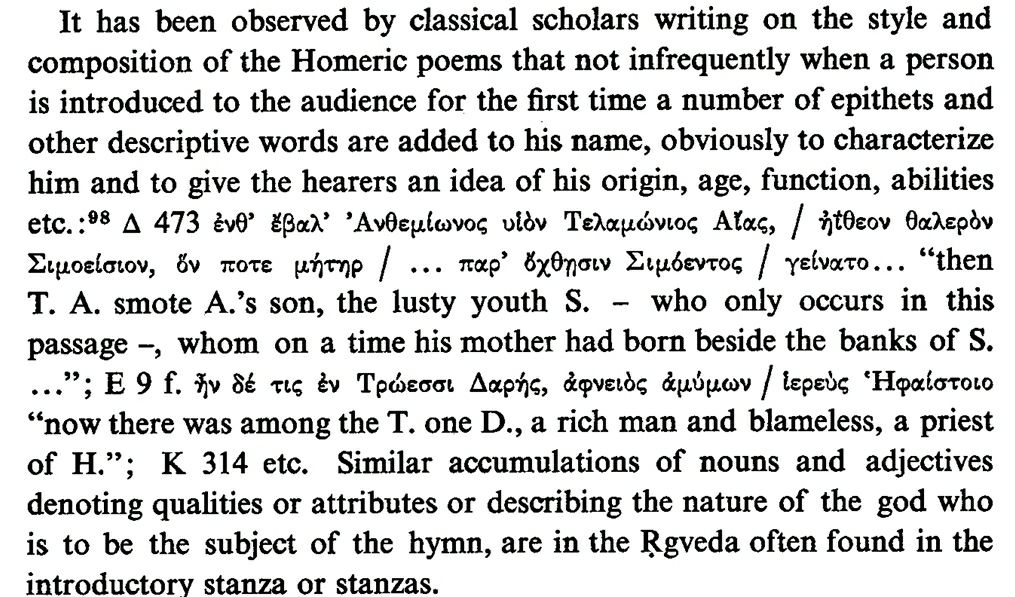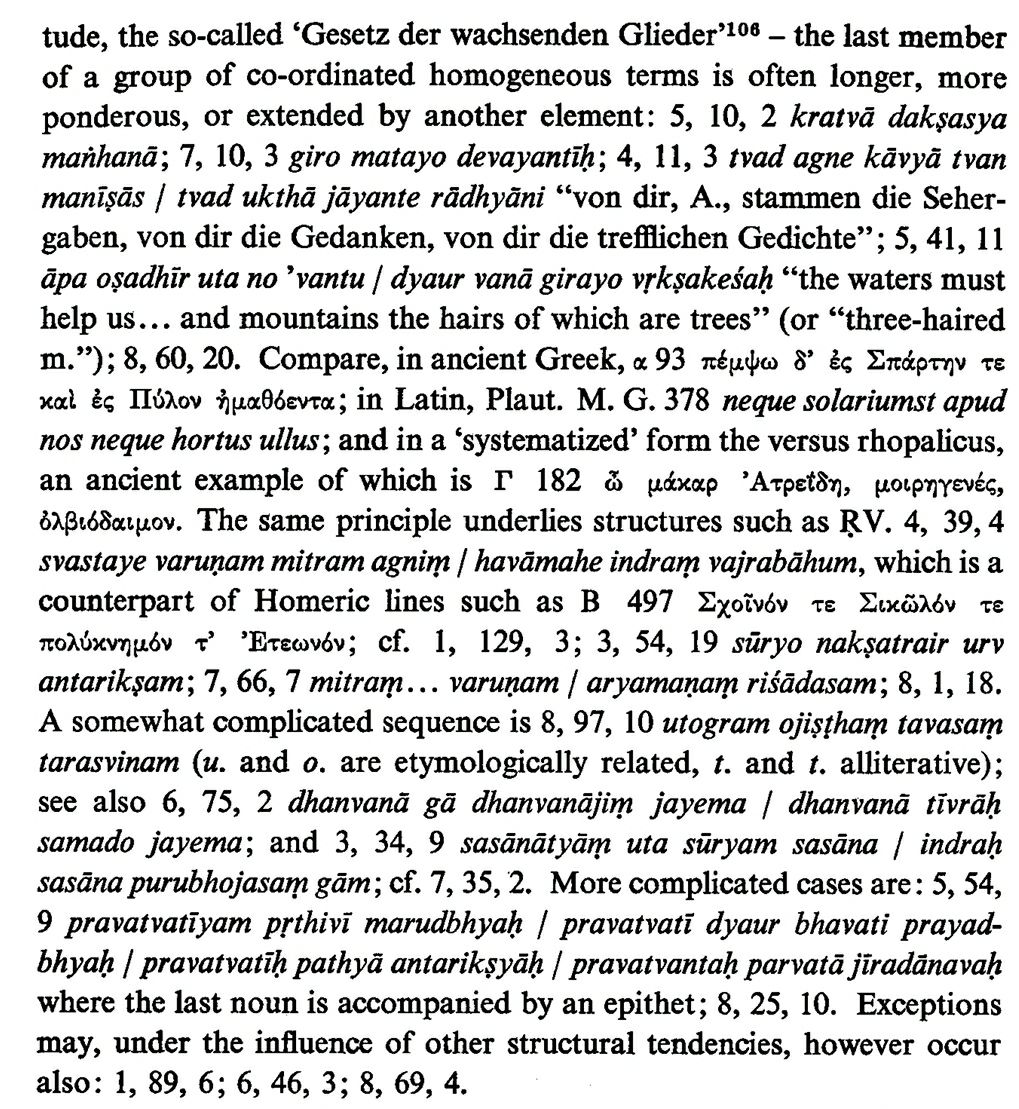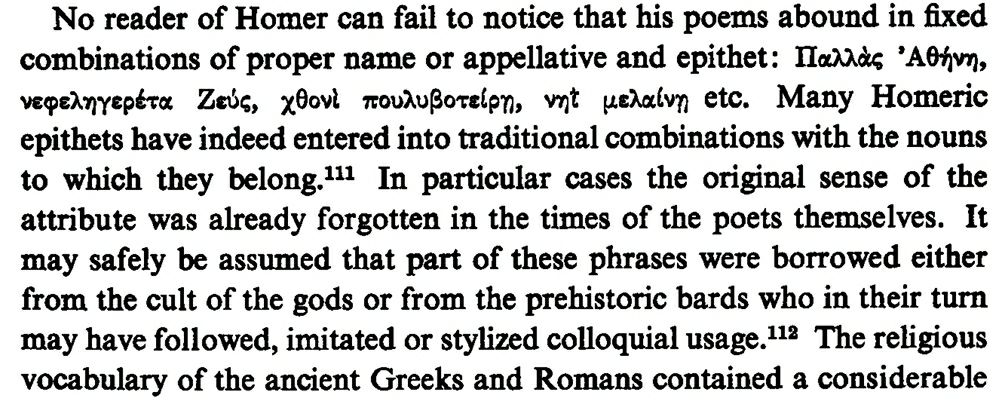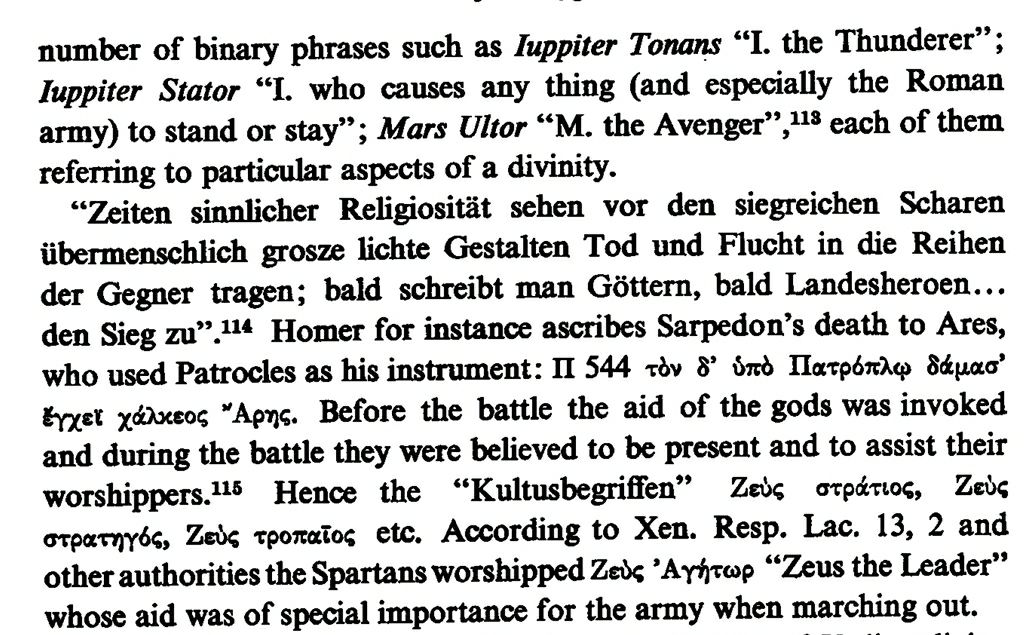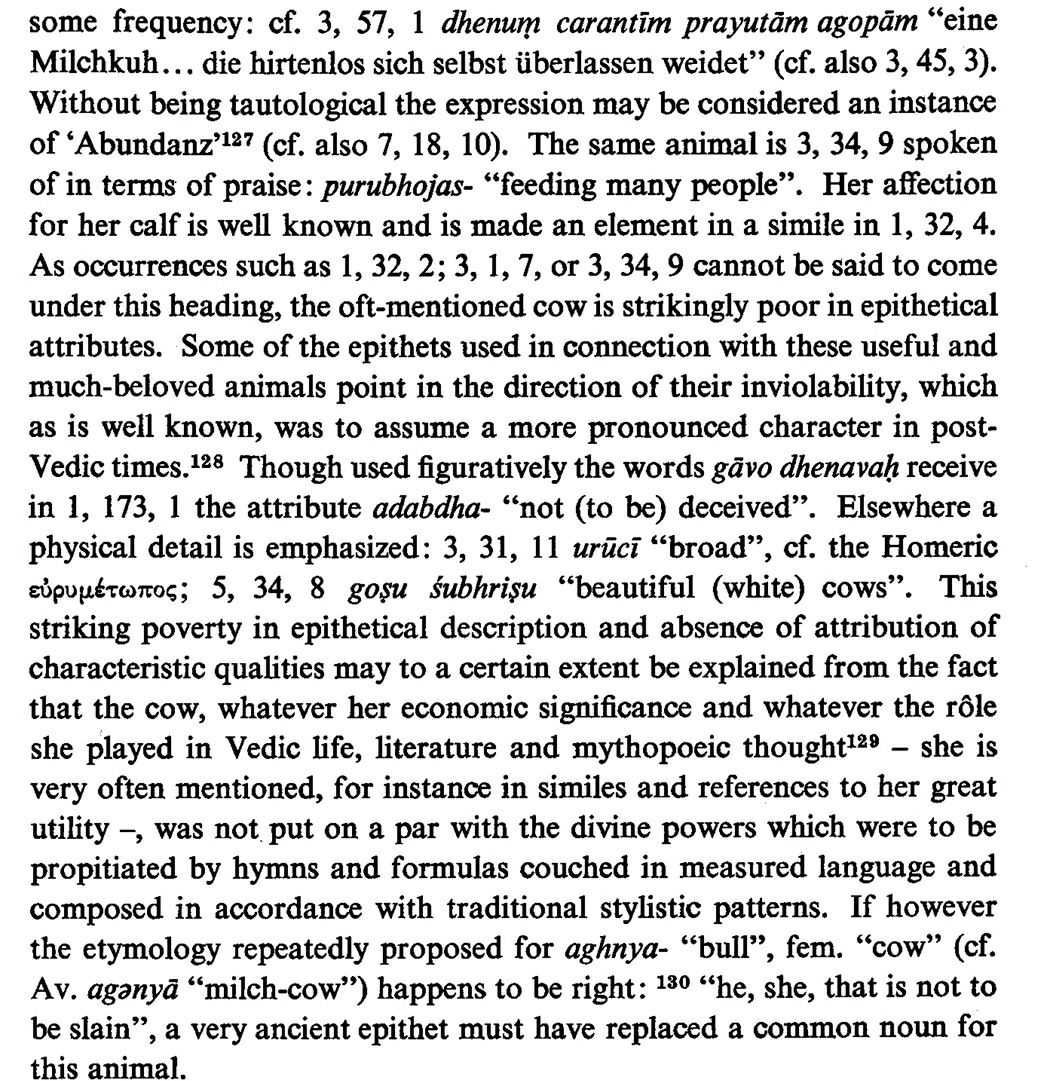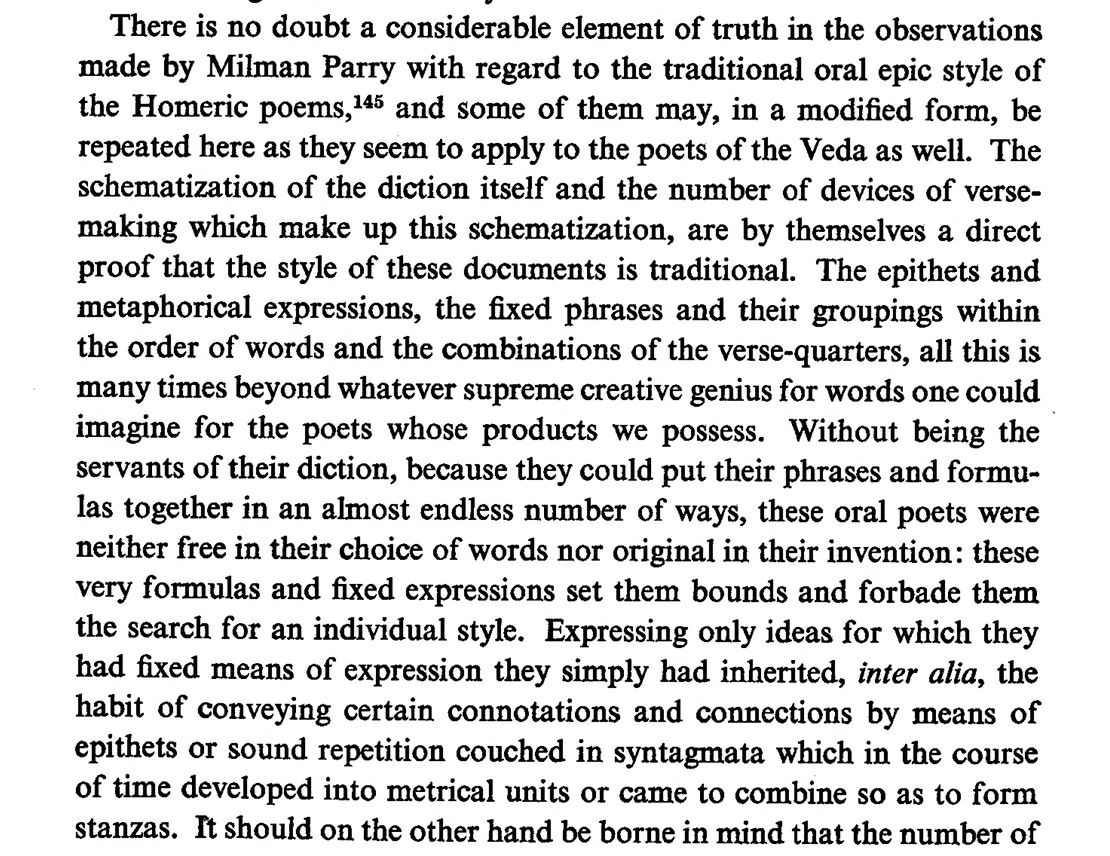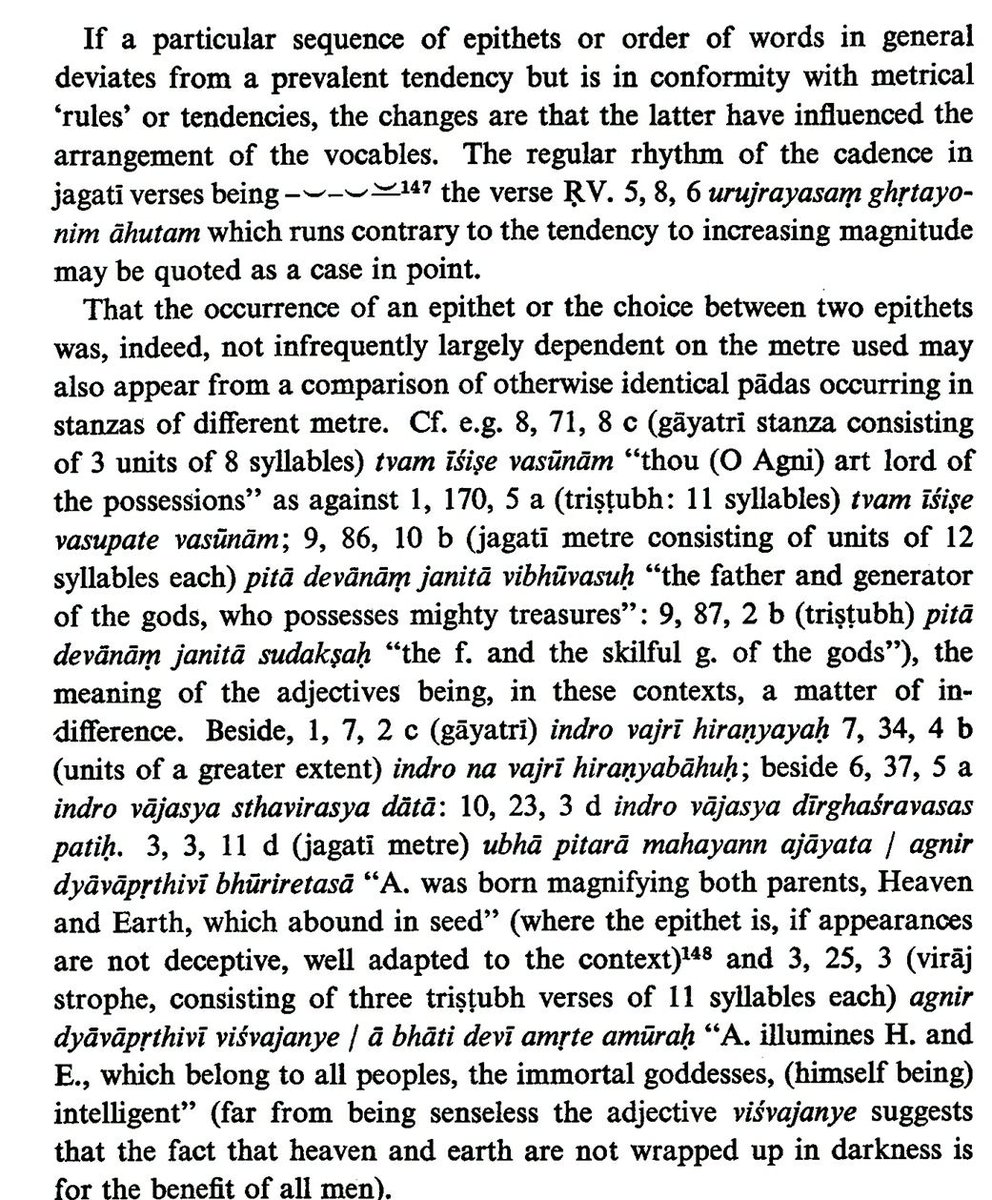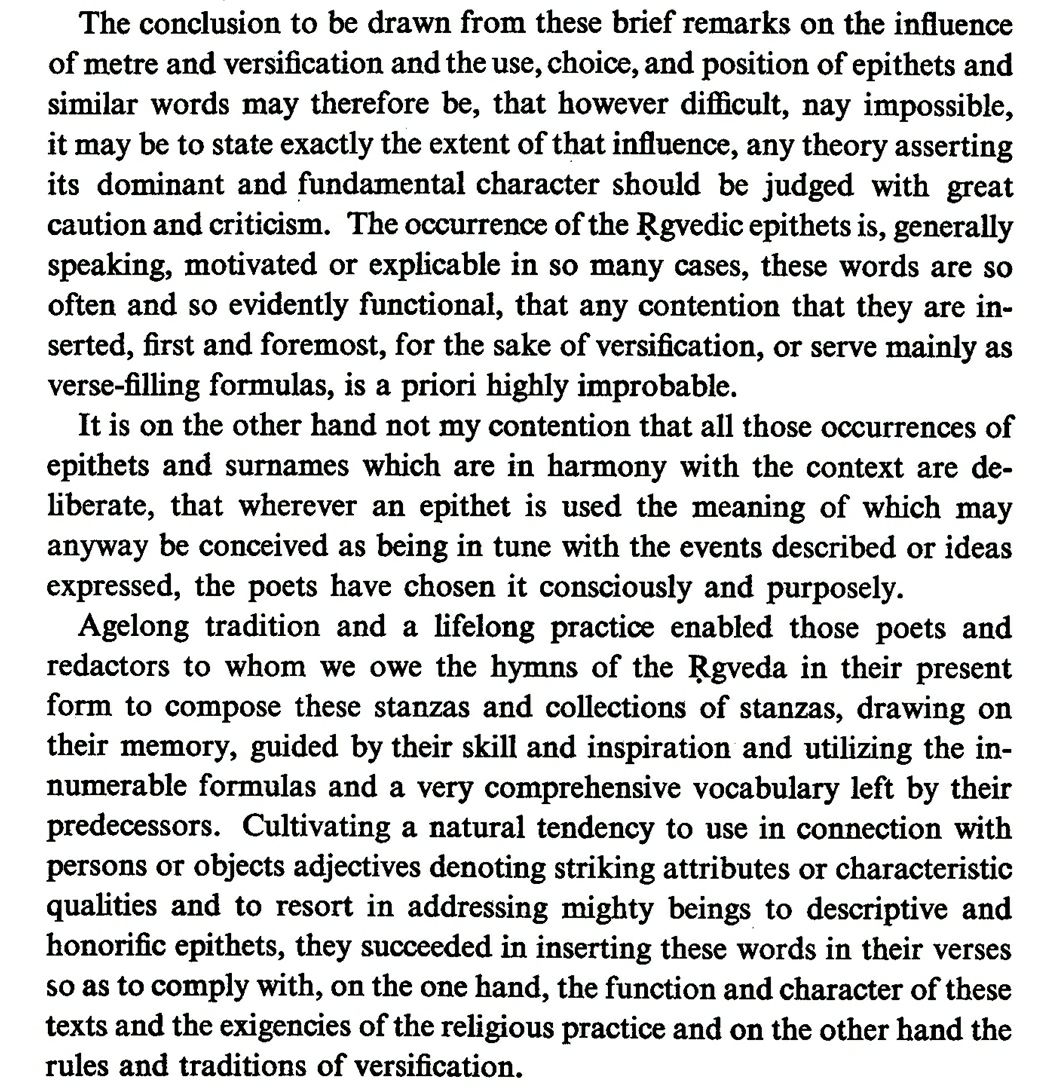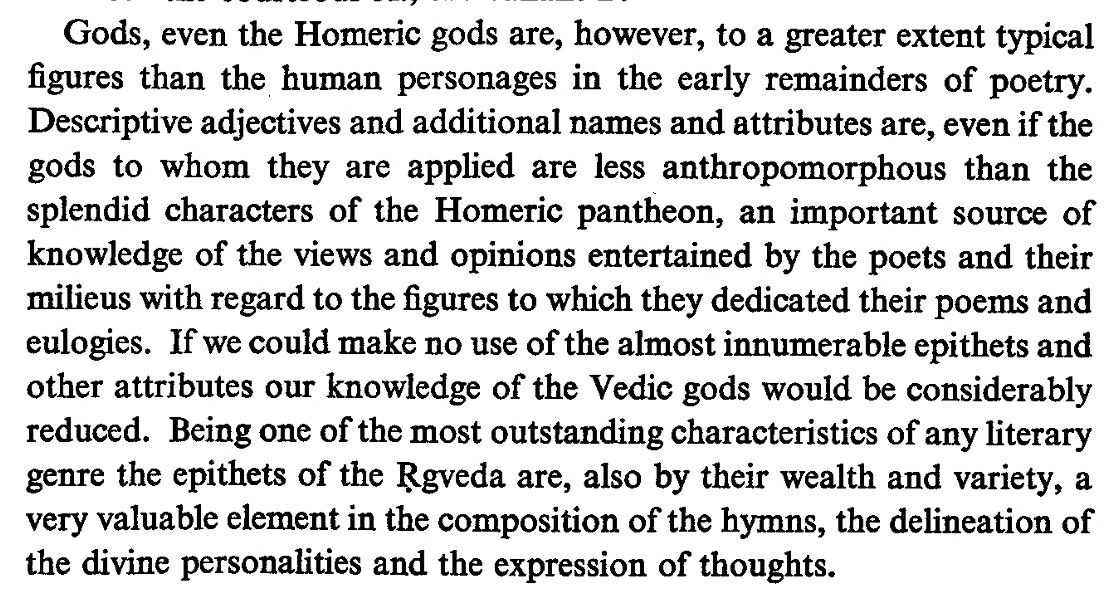Ṛgvedic epithets (via syntagmata & other devices) are of special interest in lieu of other bardic compositions (such as Homer's Iliad) which serve to illumine aspects of a deity's characteristics including ie., divinity, omniscience & engage the audience of the bard.
A note can be made on the historicity of epithets in ancient Indo-European languages. The preference for adjectives over adverbs/prepositions/conjunctions explains the 'marked predilection' for decorative epithets, though the adjective can also indicate the purport of sentence.
The recurrent usage of certain words utilized as epithets are employed to qualify statements that were in the eyes of the ancient poets unambiguous facts. That is to say, such statements served more than just as didacticism, but also as testimony. The frequent epithet of ugra- is
ascribed to Indra in ṚV 4.16.20, ugra avitā tanūpāḥ (powerful helper & protector of our bodies), in ṚV 4.23.7 as the powerful avenger of debts, in the so called Vālakhilya hymns ṚV 8.52.4-5 as the powerful promoter of the lordly position of his devotees as ugra iśānakṛt
In opening stanzas, an extended string of epithets can serve to illuminate different aspects of a deity's nature, a device used to impress their multivariegated nature unto minds of the audience (ṚV 1.143.1 spiel on Agni). Frequent use of epithetical words can occur as attrib
utive adjectives can be regarded as anaphorical especially in ṚV 7.71.5 ni pe̱dava̍ ūhathurā̱śumaśva̍m where simple mention of made of a horse offered to Pedu by the Aśvins. Sometimes numerical superfluity is utilized to signify the important of a ritual in which ten fingers mig
ight not be needed to prepare a fire or soma. Pañca kṛṣṭiṣu (Five Tribes People) in ṚV 2.2.10 denote the confederacy of Aryan tribes to differentiate against other extant settlements.
Epithets can determine which noun is in contention like in ṚV 1.143.5 & 1.176.3 where the word aśani qualified by divyā denotes the 'tip of a missile'. They can be used predicatively ie., Agni= sacerdotal, messenger of the Aryans, carrier of oblations, hotṛ, lord of settlers.
Translations can often induce the reader to regard adjectives in certain stanzas as part epithets, part appositional phrases, or an apposition serving as an epithet. Subordinate nominal groups can fulfill functions of an apposition. Nominal groups can accompany a governing noun.
The adjective Govid-(acquiring or procuring cattle) occurs in connection with Indra in the Vālakhilya hymns whereas it used as a title in other places to qualify the god. Śiva in ṚV 10.92.9 applied to Rudra superseded the old name perhaps by an unconscious attempt by his worship
pers to make him refrain from evil by pronouncing his favorable epithets.
Epithets can assume the character of substantives and proper names. For eg, in ṚV 1.80.1 śūra vajrivaḥ, ie wielder of the vajra is used to signify Indra himself as the killer of Vṛtra w/o naming Indra.
Epithets can assume the character of substantives and proper names. For eg, in ṚV 1.80.1 śūra vajrivaḥ, ie wielder of the vajra is used to signify Indra himself as the killer of Vṛtra w/o naming Indra.
Bipartite Combinations in which an epithet is placed appositionally w/the proper name they qualify: uṣo maghoni, viṣṇur gopāḥ, dyauṣ pitaḥ pṛthivi mātaḥ. Reverse appositions are also seen (rājā varuṇaḥ). A parallel is seen in Greek w/Ζεῦ πάτερ & in Latin rex Persarum
Sometimes a name is immediately followed by a plurality of epithets. See AV 2.27.6 rudro jalāṣbheṣaja/nīlaśikhaṇḍa karmakṛt O Rudra thou of appeasing remedies dark crests performer of deeds w/the famous Homeric Ἆρες Ἄρες βροτολοιγὲ μιαιφόνε τειχεσιπλῆτα' from the Il.5.31
Astute positioning of epithets vis a vis other elements in a pāda, proper names are a result of the exigencies of versification. They can serve to achieve a varied diction & well balanced structures of the stanzas. The bards could achieve these for stylistic & literary effects.
'Archaic' tautological parallelisms (a deity being invoked first by name, then by an epithet in a later stanza or pāda to introduce & emphasize elements of variation) are far from rare. They served to propitiate divine powers in the most efficacious manner for desirable results.
The uncertainty surrounding the most agreeable way to address gods accentuated this style which was as much a product of emotional effusion to deities as it was a device in combinatorial distributional versification of epithets and appellations. See Plato Cratylus 400e ὥσπερ ἐν
ταῖς εὐχαῖς νόμος ἐστὶν ἡμῖν εὔχεσθαι, οἵτινές τε καὶ ὁπόθεν χαίρουσιν ὀνομαζόμενοι (that we call them, as is customary in prayers, by whatever names & patronymics are pleasing to them, since we know no other). For eg Roman pontifices used to commence their prayers
with Iuppiter ptime maxime sive quo alio nomine te appellari volueris (Jupiter Optimus Maximus, or if you so wish to be called by any other name). An Homeric tautological parallel to ṚV 1.2.7 mitraṃ huve pūtadakṣam varuṇaṃ ca riṣādasam (I call upon Mitra of refined skill &
Varuṇa who cares for the stranger) is Il.1.7 Ἀτρεΐδης τε ἄναξ ἀνδρῶν καὶ δῖος Ἀχιλλεύς (Atreus' son the lord of men and brilliant Achilleus) where the Skt has two successive pādas w/name & an epithet, while the Greek also chiastically positions 2 word groups successively
The epithet in a stanza may be the only indication of the divinity meant by the poet. In ṚV 5.32.4 vṛṣaprabharmā dānavasya bhāmaṃ vajreṇa vajrī ni jaaghānaa śuṣṇam (it was the hisser Śuṣṇa that the mace (bolt*)bearer smashed down with his mace*) Indra is superfluously
alluded to w/the paronomastic addendum vajrī to vajreṇa. Agni in ṚV 10.124.3 refers to his ritual aspect reflexively as the guest among the other sacrificers. Indra simply w/epithets śūraḥ/hero; vṛtrahan/conquestor of Vṛtra & Soma w/ṛjīṣin from the sediment in ṚV 8.79.4
Sometimes a frequent epithet comes to replace the proper name or becomes stereotyped to such an extent it itself assumes a qualification. For example, Agni is frequently qualified by havyavāhaṃ (oblation bearer) and Soma with babhru- the reddish brown one.
Epithets become so called 'stock epithets' due to their conventionality but are reinforced by the bard to visualize perceptibility of certain elements to the audience. Compare from OD.5.410 ἔκβασις οὔ πῃ φαίνεθ' ἁλὸς πολιοῖο θύραζε (no exit out of the gray sea appears
anywhere) ie., when Odysseus is about to reach the shore, the broken ocean verily appears gray (qualifies 'sea') near the coast while in ṚV 9.79.5 evā ta indo subhvaṃ suupeśasaṃ, the soma draught (sap) is qualified w/'excelling in splendor’.
Some epithets are very rare, but appropriately employed. Indra is invoked for a military expedition in a threefold paronomasia in ṚV 6.32.3 as the destroyer of strongholds. In ṚV 1.96.4, Mātariśvan (in addition to finding fire for mankind)
is qualified as puruvārapuṣti for 'finding' free space for the bucolic Aryans. Indra's horses (having beautiful conspicuous tails) are called mayūroman- Interestingly a rare epithet can be chosen to express common knowledge for eg Indra's generosity earns him the title mehanāvān
An epithet that functions indicatively in a typical fashion include ṚV 10.138.3 & 6.31.3 w/respect to the power of māyā which is commonly associated with asuras who wield its power. In ṚV 6.28.4, the battle-horse is referred to as reṇukakāṭaḥ ie. whose head is covered w/dust
Sometimes the aforementioned conventionality of an epithet is deliberately preferred by the poet as to make a larger point. Preserved in Plut. De Tranq. 10, Archilochus says οὔ μοι τὰ Γύγεω του̂ πολυχρύσου μέλει (No care have I of Gyges' golden store), the poet specifically
mentions the wealth of the Lydian king to remonstrate against the conceit of wealth. Similarly Vedic poets explain the divine origin of the soma draught as being brought from heaven by the eagle, address Soma in the same breath as rain-bringing Parjanya w/vṛṣṭimat- likening...
the flow of either liquid with water.
Few epithets are emotionally generated by the poet for eg., broadness suggests safety; extols of potability unto the divine river Sarasvatī. Others time elliptical repetitions are used metaphorically for eg., most excellent charioteer in...
Few epithets are emotionally generated by the poet for eg., broadness suggests safety; extols of potability unto the divine river Sarasvatī. Others time elliptical repetitions are used metaphorically for eg., most excellent charioteer in...
one instance characterize Pūṣan / who was earlier invited to the the charioteer of the rite.
Adjectives like ghora- (dreadful; venerable) have an applicability from extols to vengeful incantations. Purubhojas- (feeding many) can be used for female bovids, or cows while anyavratāḥ (devoted to other gods) is employed for Dasyus. Bahuvrīhis are akin to Homeric epithets.
Though many epithets are indeed very lofty, the Vedic poets moreso sought to praise or confirm the power of a divinity which was common knowledge so as to consolidate their legitimacy rather than to impart new knowledge or some esoteric aspect of the divinity to the audience.
Epithets need not manifest in synchronous actualization per se, but rather serve to laud the greatness of the their gods (vṛṣabho vṛṣṇyāvān bull w/manly power). Ancient H whose stanzas were replete w/such epithets thus demonstrated the vitality in continuity of the deities
Laudatory panegyrics immediately followed by orisons was characteristic of both Vedic & Homeric hymns. Compare ṚV 2.33.11 "Sitting upon the high seat (chariot)...have mercy on the singer...Rudra" with the Ὁμηρικοὶ Ὕμνοι 8.1 "Ares..chariot-rider...hear me helper of men”.
A possible parallel phenomenon that occurs in the Greek, that is a 'shift of meaning' of a title otherwise conferred upon a god unto those invoking him. Zeus is called ἆφίϰτωρ (Suppliant) used to refer to the daughters of Danaos by Aeschylus whereas Indra is Yajyu-
Amplified characterizations (to lessen the abstract sense by the utterance of the epithet) achieve a refined style (substantival periphrasis) are employed by Homer in Il. 16.189 κρατερὸν μένος Ἀκτορίδαο & in ṚV 6.6.7 which prefer an adjective as opposed to a dependent genitive
Descriptory eptithets for gods instead of their name is considered a dignified style typical of Aristotle & Vedic poets (blue vault of heaven=sky; dustless paths=open space). Gods are given epithets w.r.t to their abode Zeus=αἰθέρι ναίων Il.2.189; Viṣnu= girikṣhit ṚV 1.154.3
Some discussions about the the phenomenon of enallage with examples from the Roman author Petronius, Kathopanishat, and by the tragedian Sophocles.
An interesting epithet to note is that of the rain shed by the Maruts which is often symbolically stated as milk or ghee and even honey. In ṚV 1.87.2, ghṛtam ukṣatā madhuvarṇam archate (sprinkle ghee the color of honey for he who chants) is invoked in association with gold.
Paronomastic combinations/stylistic repetitions were a 'habit' of ancient Indo-European authors. Compare Il.10.315 πολύχρυσος πολύχαλκος (polychrysos polychalkos ie, Dolon..a man of much gold & much bronze) & ṚV 8.93.17 puruṇāman puruṣṭuta (you of many names, praised by many)
The Ásvins are often called bulls and likened to buffalos (gaura-), while guest (atithi-) is associated with Agni. Varuṇa is often conferred the epithet of māyin- due to him being the ideal representation of one who possess māyā. These similes can occur concurrently in groups.
Within traditional circles, perspective of the ancients was completely in terms of magico-religious conceptions of esoteric powers of the gods, the poets anthropomorphized deities. This produced a large number of metaphors with a decidedly anatomical tone.
The phenomenon of 'linguistic superstition' seemingly influences the words of the ancients out of fear of causing anger to the gods. An epithet associated w/one deity is conferred unto another. A chain of epithets can be used enhance the power of the god or deprecate his wrath.
Cumulation of epithets are common to both Vedic & Homeric metrical poetry. See ṚV 8.44.10 vipraṃ hotāraṃ adruhaṃ/dhūmaketuṃ vibhāvasum (inspired hotṛ../smoke-bannered one..) w/Il.294-5 ...ἔσχετο πάντοσ' ἐΐσην καλὴν χαλκείην ἐξήλατον (...circular bronze/hammered shield)
When a person is introduced for the 1st time in Homeric poems, like introductory Ṛgvedic stanzas, accumulations of descriptors/epithets are used for characterization. The last member of coordinated homogenous terms in epic poetry is often longer or has an extra element. Compare
RV.5.41.11 āpa oṣadhir uta no 'vantu dyaur vanā girayo vṛkṣakeśah (the waters must help us...and mountains the hairs of which are trees); Od.1.93 πέμψω δ' ἐς Σπάρτην τε καὶ ἐς Πύλον ἠμαθόεντα (will send him to Sparta and sandy Pylos).
Fixed combinations of proper names in Homeric literature/binary phrases in Ancient Greek & Roman literature (Iuppiter Tonans). For eg., Xenophon in his Λακεδαιμονίων Πολιτεία notes that Spartans worshipped & invoked Διί Ἀγήτορι (Zeus the Leader) before any army embarkment.
Epithets in connection with bovids in post-Vedic times was not lost on Homer (see Il.10.292 ἦνιν εὐρυμέτωπον broad fronted heifer w/ṚV 3.31.11 urūcya̍smai...gauḥ cow of broad extent). The utility of the cow in Vedic life is evident by the epithet aghnya- not to be slain.
A survey on the style on traditional oral epic Homeric & Ṛgvedic poetry: schematization of diction, combinatorial metaphorical expressions, syntagmata development into metrical units, repetition of ideological attitudes. Occurrence of epithets was dependent on metrical choice
Important to note that from the PoV of the poets, words & epithets were functional first & foremost for the exigencies of religious practice & impressing upon the audience the powers of the gods rather than a method for achieving versification (though Homer's epithets show it).

 Read on Twitter
Read on Twitter